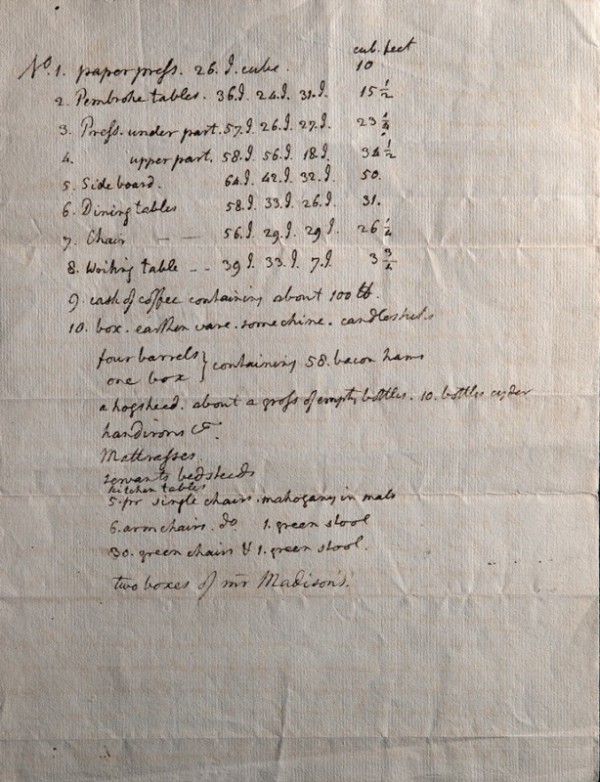
Thomas Jefferson, packing list, New York City, August 31, 1790. Pen and ink on paper. (©Thomas Jefferson Foundation at Monticello; photo, Gavin Ashworth.)

Dining room at Monticello, Albemarle County, Virginia. (©Thomas Jefferson Foundation at Monticello; photo, Philip Beaurline.) The side chairs are attributed to Thomas Burling, New York City, 1790.

Louis-Jacques Goussier, «Layetier,» Supplément à l’Encyclopédie ou Dictionnaire raisonné des sciences, des arts et des métiers, vol. 5 (Paris: Chez Briasson, 1762–1772). (Courtesy the ARTFL Encyclopédie Project, University of Chicago.)
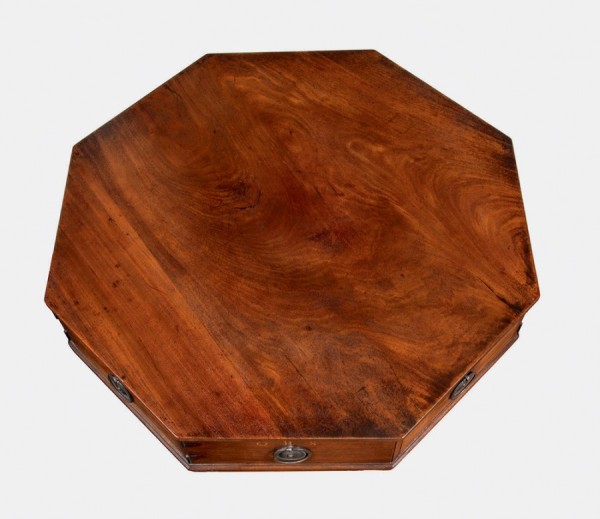
Detail showing the octagonal top of a writing table attributed to New York City cabinetmaker Thomas Burling. (Collection of the Massachusetts Historical Society; photo, Gavin Ashworth.)

Library at Monticello, Albemarle County, Virginia. (©Thomas Jefferson Foundation at Monticello; photo, Gavin Ashworth.) The writing table and armchair with Thomas Jefferson’s shipping brand were likely used in this room.
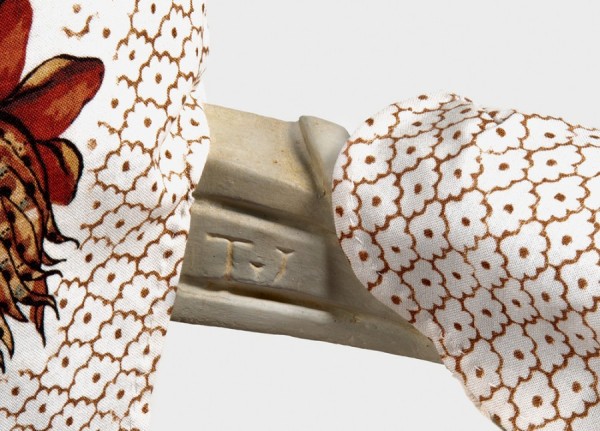
Detail of Thomas Jefferson’s shipping mark branded on the arm of a chair packed and shipped from France. (©Thomas Jefferson Foundation at Monticello; photo, Gavin Ashworth.)
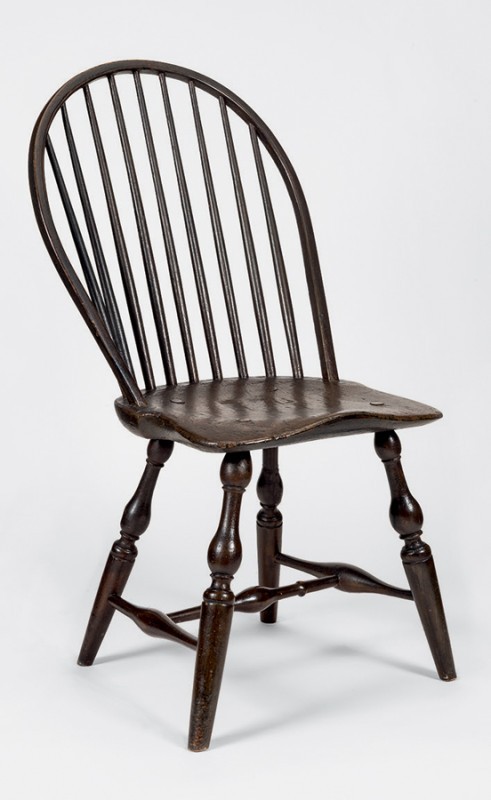
John Always, side chair, New York City, ca. 1790. Tulip poplar (seat), soft maple (left rear leg), maple (medial stretcher), and hickory (center spindle and back rail). H. 35 5/8", W. 18 3/4", D. 20 1/4".(Courtesy, Winterthur Museum.)
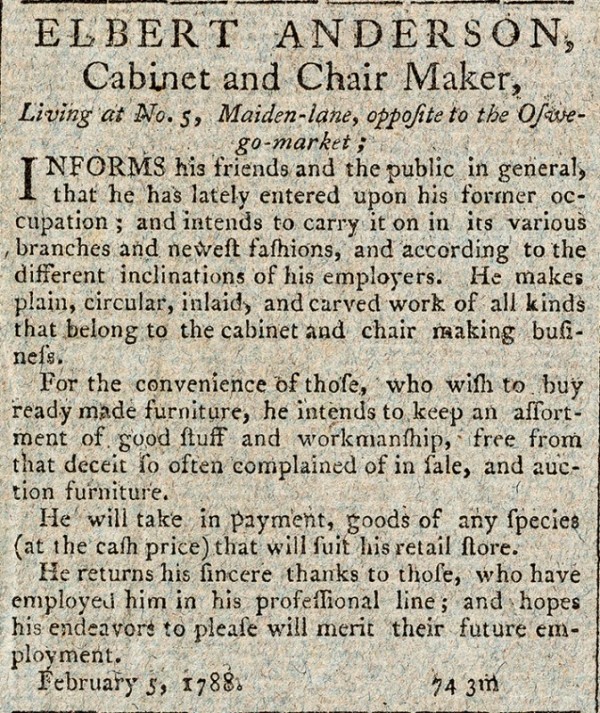
Advertisement for Elbert Anderson, New-York Packet, February 8, 1788. (Courtesy, American Antiquarian Society.)

Elbert Anderson, secretary-andbookcase, New York City, 1786–1796. Mahogany with unidentified secondary woods. H. 88 7/8", W. 49 3/4", D. 24 1/4". (Courtesy, Christie’s.)

Detail of the label on the secretary-and-bookcase illustrated in fig. 9 (Courtesy, Christie’s).
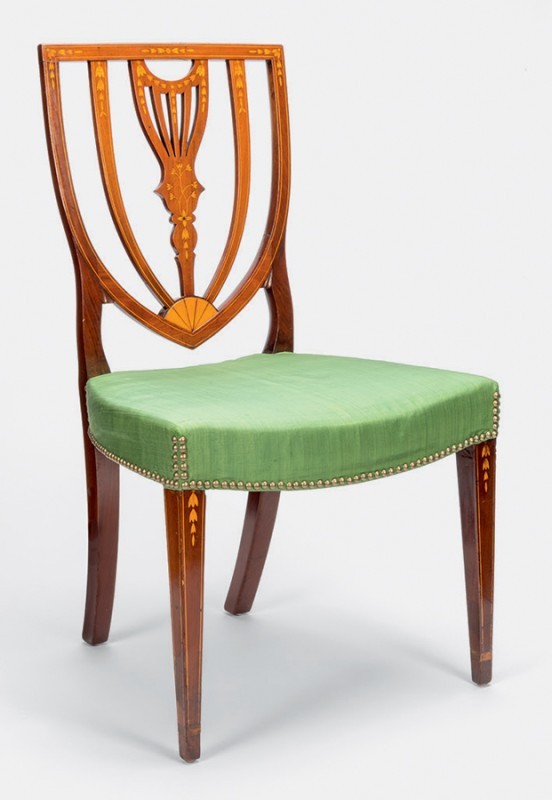
Elbert Anderson, armchair, New York City, 1790–1800. Mahogany with beech and maple. H. 36 3/8", W. 21", D. 19 7/8". (Courtesy, Winterthur Museum.) This chair is part of a large set ordered by Alexander and Elizabeth Schuyler Hamilton.
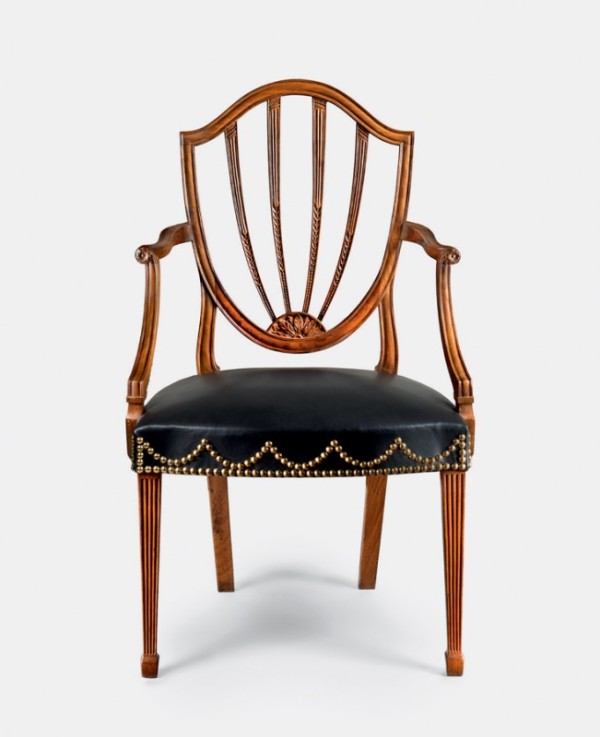
Armchair, attributed to Elbert Anderson, New York City, 1790. Mahogany with hackberry or elm. H. 37 3/4", W. 21 3/4", D. 18 1/4". (©Thomas Jefferson Foundation at Monticello; photo, Gavin Ashworth.)
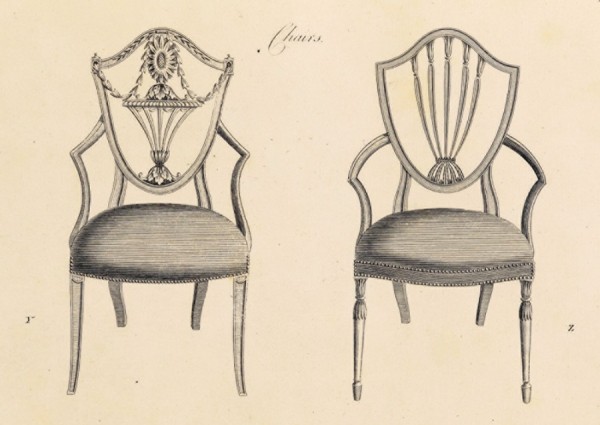
Design for “Chairs” illustrated on pl. 9 in George Hepplewhite’s Cabinet-Maker and Upholsterer’s Guide (1788). (Courtesy, Winterthur Museum.)
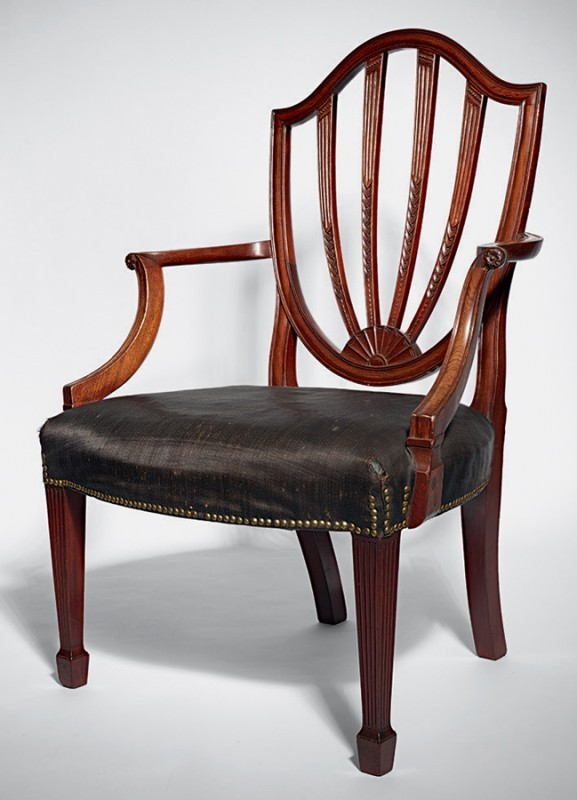
Armchair attributed to Thomas Burling, New York City, ca. 1790. Mahogany with oak. H. 40", W. 28", D. 17". (Courtesy, Division of Cultural and Community Life, National Museum of American History, Smithsonian Institution.)

Alexander Anderson to Charles Thomson, invoice dated February 2, 1786. Ink on paper. (Courtesy, Historical Society of Pennsylvania.)

Label of Samuel Prince, New York City, ca. 1765–1775. Ink on paper. (Courtesy, Levy Galleries, New York.
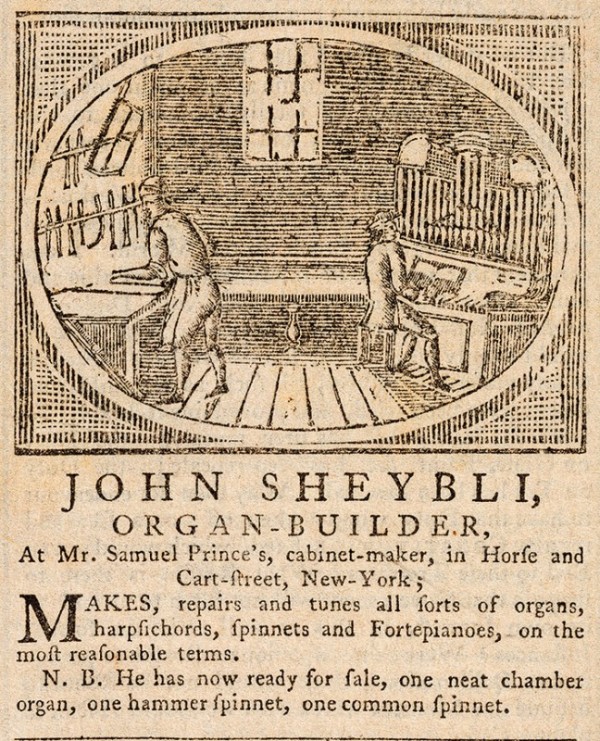
Advertisement for John Sheybli, New-York Gazette and Weekly Mercury, October 10, 1774. (Courtesy, American Antiquarian Society.)

Advertisement for Thomas Burling, Rivington’s New-York Gazetteer, March 16, 1775. (Courtesy, American Antiquarian Society.)
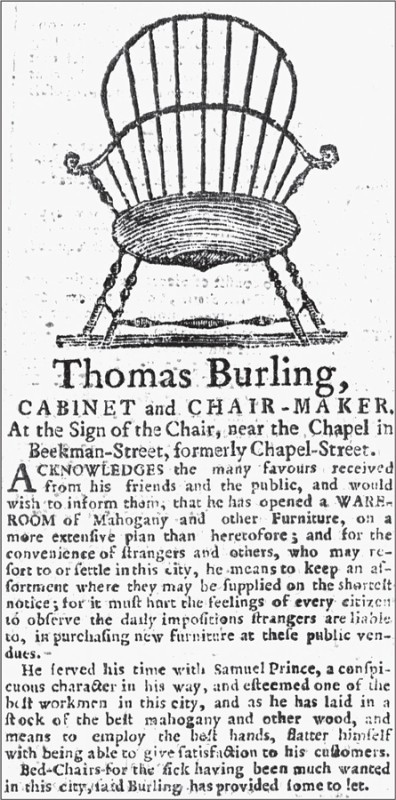
Advertisement for Thomas Burling, Daily Advertiser, Political, Historical and Commercial (New York), November 16, 1786. (Courtesy, NewsBank/Readex.)
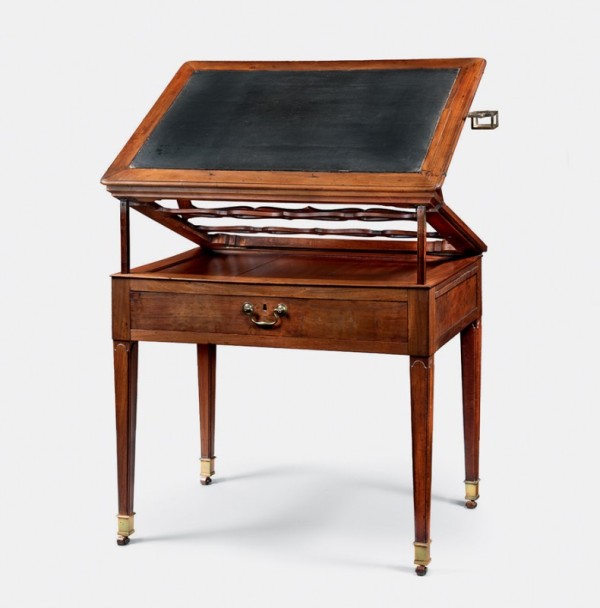
Denis-Louis Ancellet, table à la tronchin, Paris, ca. 1780. Mahogany with oak. H. 27 1/4" (closed), W. 34", D. 23". (©Thomas Jefferson Foundation at Monticello; photo, Gavin Ashworth.)
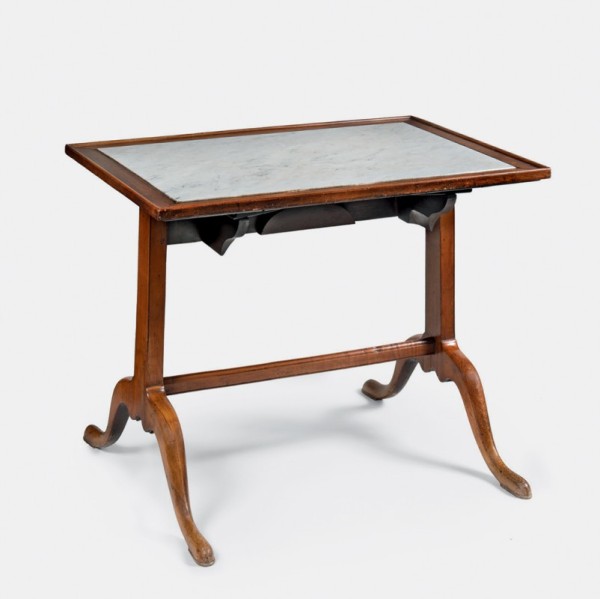
Table, possibly by Jacques Upton, Paris, ca. 1785–1789. Mahogany, oak, marble. H. 29 1/2", W. 30 3/8", D. 29". (©Thomas Jefferson Foundation at Monticello; photo, Gavin Ashworth.) This table is one of a pair.
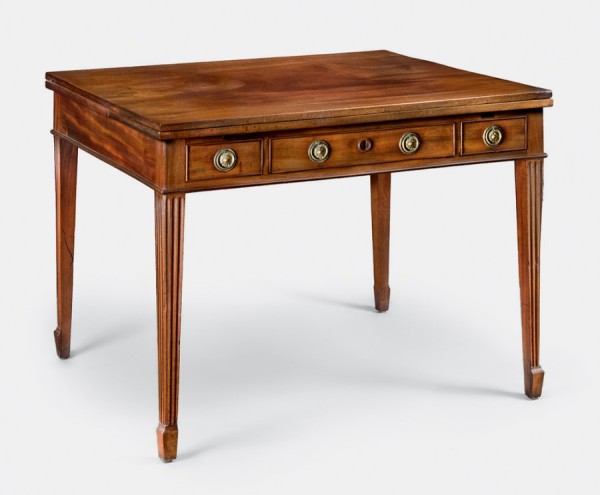
Samuel Tilt, universal table, London, 1790. Mahogany, oak, brass. H. 27", W. 36", D. 29 1/2". (©Thomas Jefferson Foundation at Monticello; photo, Gavin Ashworth.)
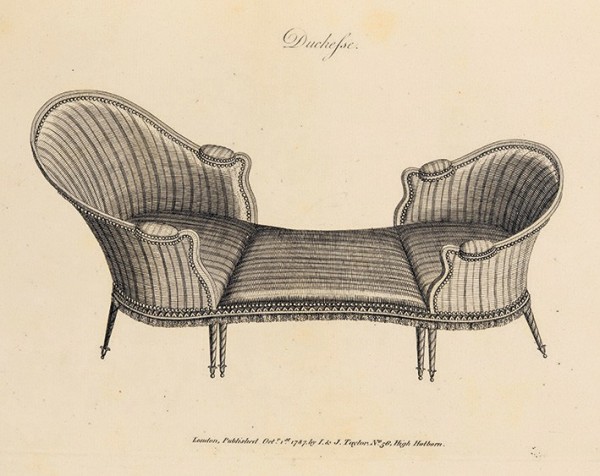
Design for “Duchesse” illustrated on pl. 28 in George Hepplewhite’s Cabinet-Maker and Upholsterer’s Guide (1788). (Courtesy, Winterthur Museum.)

Harrison Higgins Jr., sideboard, Richmond, Virginia, 2009. Mahogany. H. 37",W. 60", D. 23 1/2". (©Thomas Jefferson Foundation at Monticello; photo, Gavin Ashworth.)
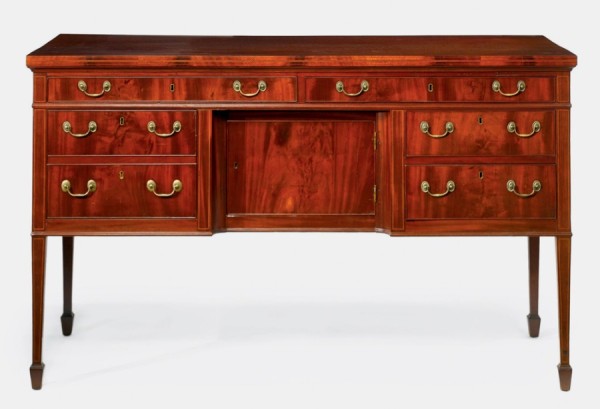
Thomas Burling, sideboard, New York, ca. 1790. Mahogany with unidentified secondary woods. H. 38 1/4", W. 64 1/4", D. 26 3/4". (Courtesy, Sotheby’s.)
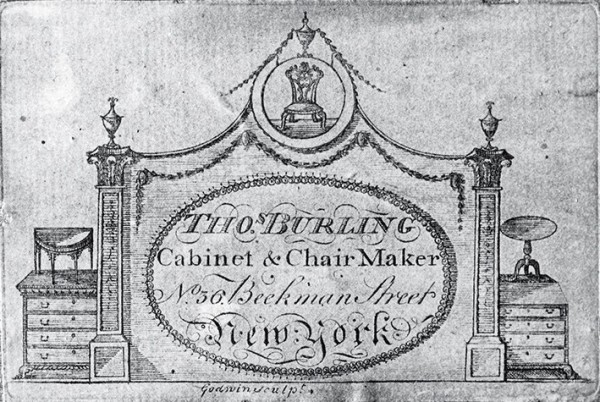
Label of Thomas Burling, New York City, ca. 1786–1793. Engraving on paper.(Courtesy, Museum of Early Southern Decorative Arts, Old Salem Museum and Gardens, WinstonSalem, North Carolina.)
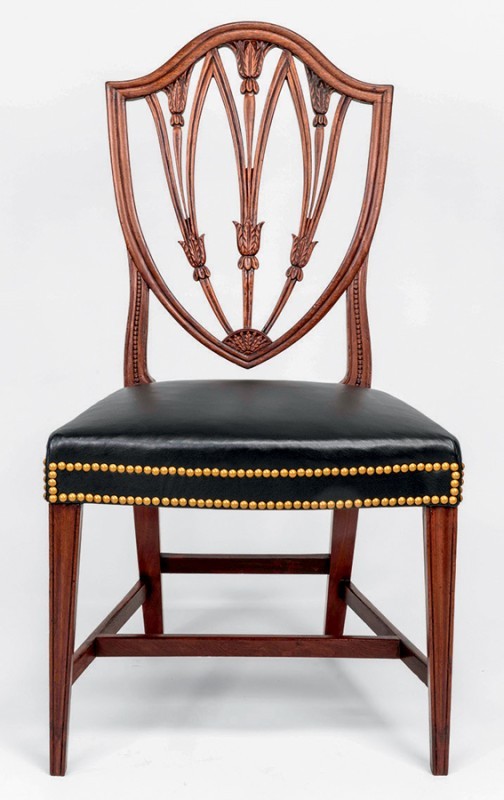
Thomas Burling, side chair, New York City, 1790. Mahogany with oak. H. 36", W. 20 1/2", D. 16 1/2". (©Thomas Jefferson Foundation at Monticello; photo; F. Carey Howlett.)
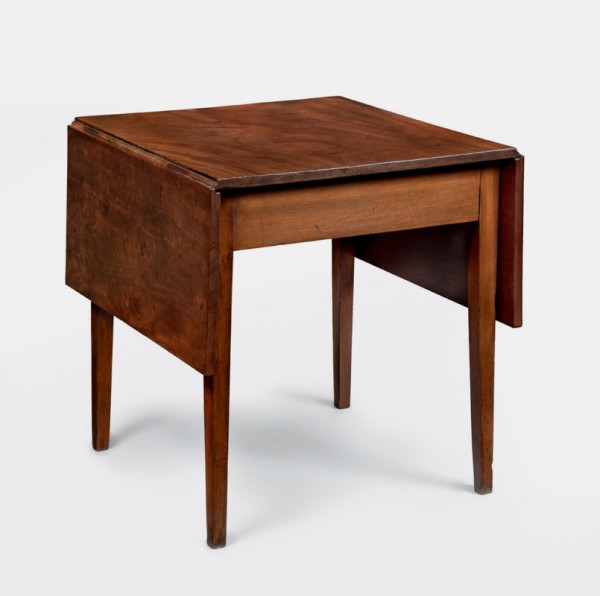
Pembroke table, attributed to James Dinsmore and John Hemmings, Monticello, Albemarle County, Virginia, 1807. Mahogany with yellow pine and cherry. H. 27 7/8", W. 26 1/8", D. 26 7/8". (©Thomas Jefferson Foundation at Monticello; photo, Gavin Ashworth.)
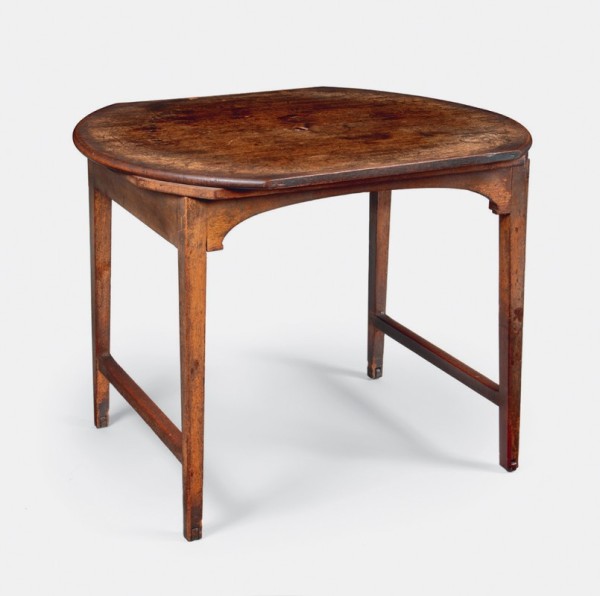
Writing table, attributed to the joiner’s shop, Monticello, Albemarle County, Virginia, ca. 1798. Mahogany. H. 29 1/2", W. 37 1/4", D. 29 7/8". (©Thomas Jefferson Foundation at Monticello; photo, Gavin Ashworth.) The base of this table may have been made in Thomas Burling’s workshop.
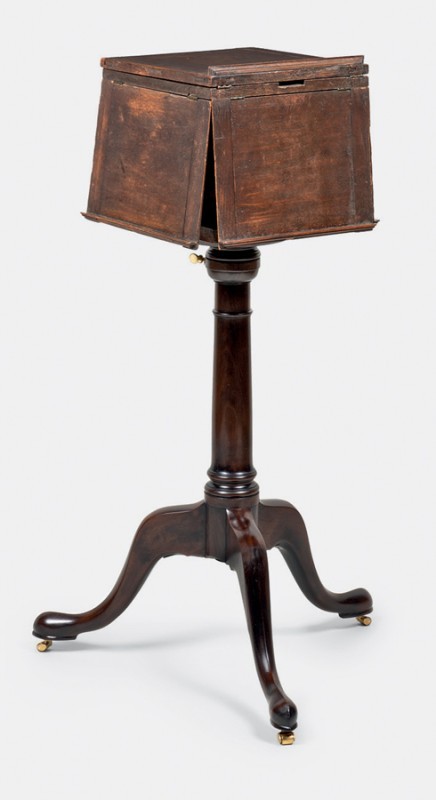
Upper section of a reading stand, attributed to Thomas Burling, New York City, 1790. Walnut. Dimensions closed: H. 11", W. 13 3/4", D. 14 1/4". (©Thomas Jefferson Foundation at Monticello; photo, Gavin Ashworth.) The tripod base is modern.

Reading stand illustrated in fig. 30, opened. (Photo, Gavin Ashworth.)
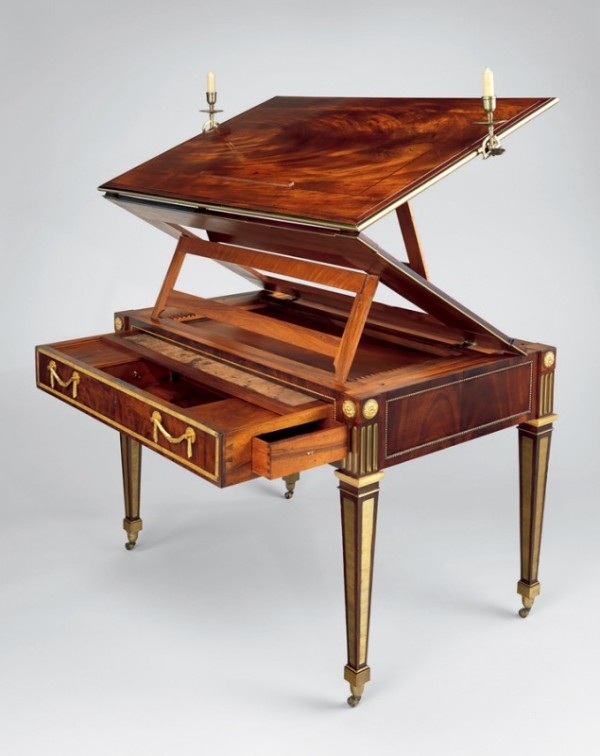
David Roentgen, table à la tronchin, Neuweid or Paris, 1780–1795. Mahogany, mahogany veneer, walnut, and cherry, with oak and pine; bronze, brass, iron, and steel. H. 31 7/8", W. 44 1/8", D. 27 1/2". (Courtesy, Cooper-Hewitt Design Museum, Smithsonian Institution.)

Detail of a detachable leg on a game table, attributed to David Roentgen, Neuweid or Paris, 1780–1783. (Courtesy, Metropolitan Museum of Art.)
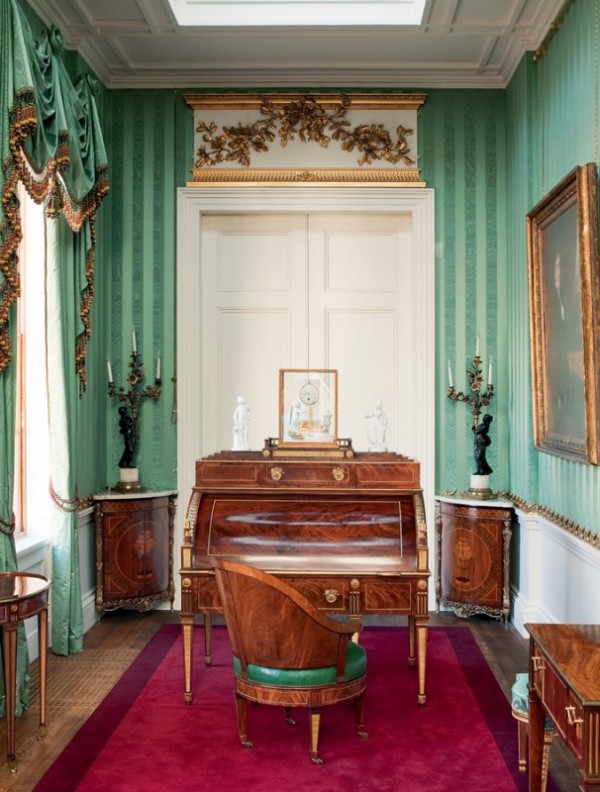
David Roentgen, bureau a cylinder and fauteuil de bureau at Chatsworth House, Neuweid or Paris, 1783–1784. Unidentified wood, mahogany, gilt bronze, leather. (Reproduced by permission of Chatsworth Settlement Trustees/Bridgeman Images.)
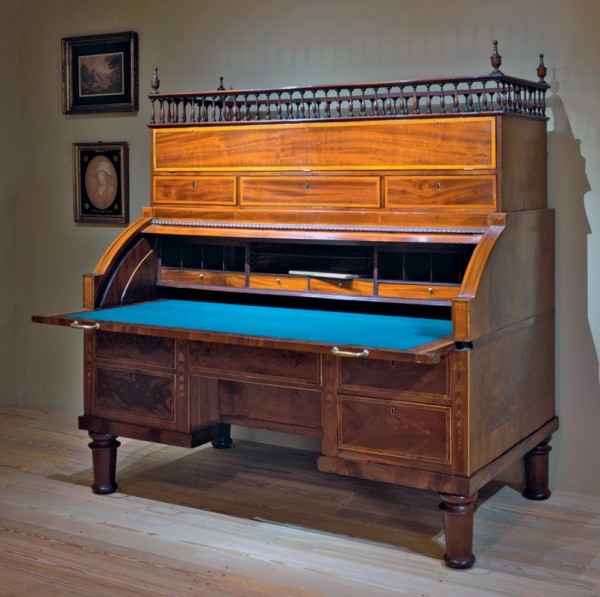
Thomas Burling, cylinder desk, New York City, 1789. Mahogany, mahogany veneer with pine, and maple. H. 66", W. 62”, D. 35". (Courtesy, Atwater Kent Collection at Drexel University, The Historical Society of Pennsylvania Collection; photo, Robert C. Lautman.) The replacement legs are shorter than the originals.
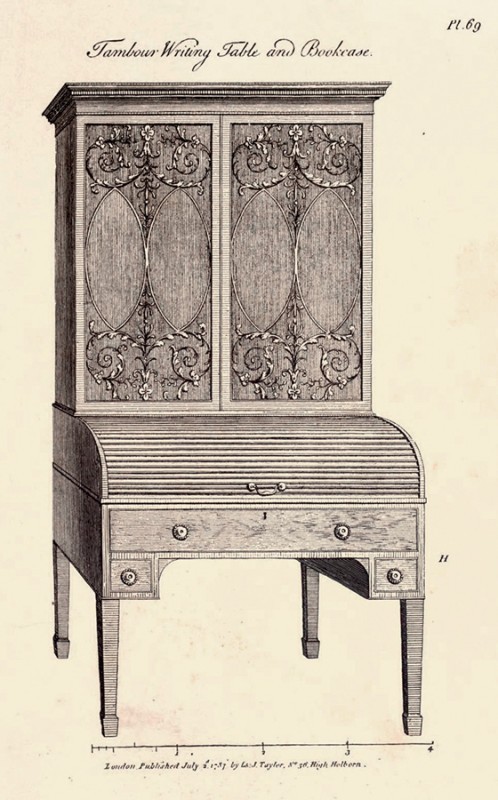
Design for a “Tambour Writing Table and Bookcase” illustrated on plate 69 of George Hepplewhite’s Cabinet-Maker and Upholsterer’s Guide (1788). (Courtesy, Winterthur Museum.)

Standing desk, probably Williamsburg, Virginia, ca. 1770. Mahogany with yellow pine. H. 45 7/8", W. 36", D. 23". (©Thomas Jefferson Foundation at Monticello; photo, Gavin Ashworth.)
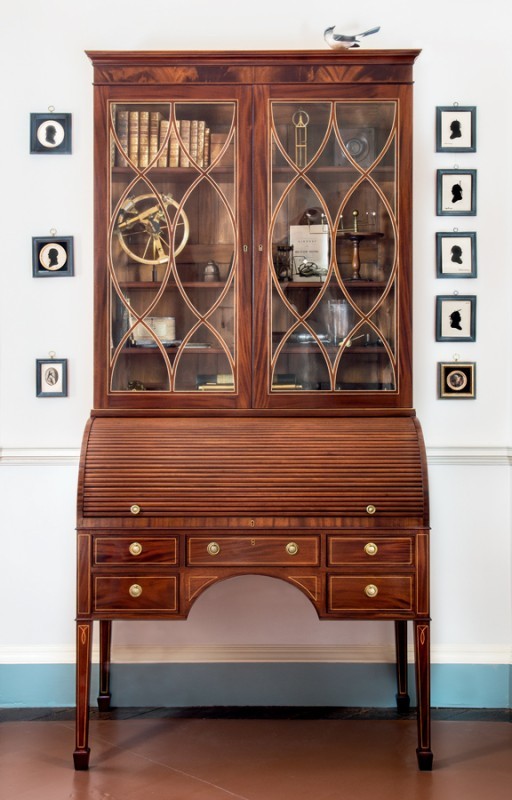
Harrison Higgins Jr., tambour writing table and bookcase, Richmond, Virginia, 2017. Mahogany and mahogany veneer with tulip poplar. H. 91 15/16", W. 44 1/4", D. 24". (©Thomas Jefferson Foundation at Monticello; photo, Gavin Ashworth.) This piece is modeled on an example from Thomas Burling’s shop.
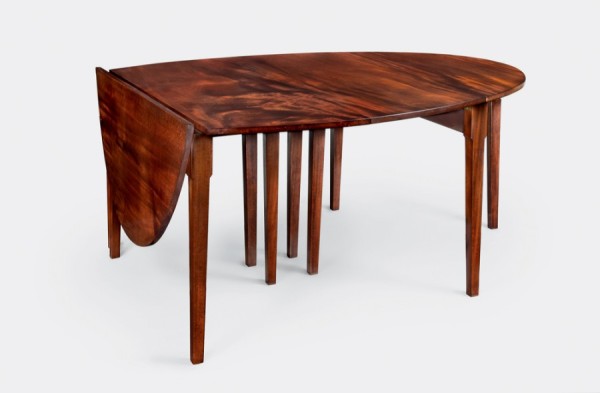
Robert R. Self, pair of dining tables from a set of seven, Albemarle County, Virginia, 1992. Mahogany with oak. Dimensions of pair closed: H. 29", W. 52", D. 4 3/8". (©Thomas Jefferson Foundation at Monticello; photo, Gavin Ashworth.) These tables, copies of the originals which are privately owned, have elliptical leaves, indicating they are end sections. Five rectangular sections could be introduced to make a larger table.

Thomas Jefferson, “Notes on a Tour through Holland and the Rhine Valley,” 1788. Ink on paper. (Courtesy, Thomas Jefferson Papers, Special Collections Research Center, William & Mary Libraries.)

Thomas Burling, revolving armchair, New York City, 1790. Mahogany and mahogany veneer with ash; iron and brass. H. 48", W. 25 7/8", D. 31". (©Thomas Jefferson Foundation at Monticello; photo, Gavin Ashworth.)

“250th Anniversary of New York City is also the 100th Anniversary of City Hall—Historic Relics which the Old Building Contains,” New York Tribune Illustrated Supplement, May 24, 1903. (Courtesy, Library of Congress.) The speaker’s or vice president’s chair was made by Thomas Burling in 1789.
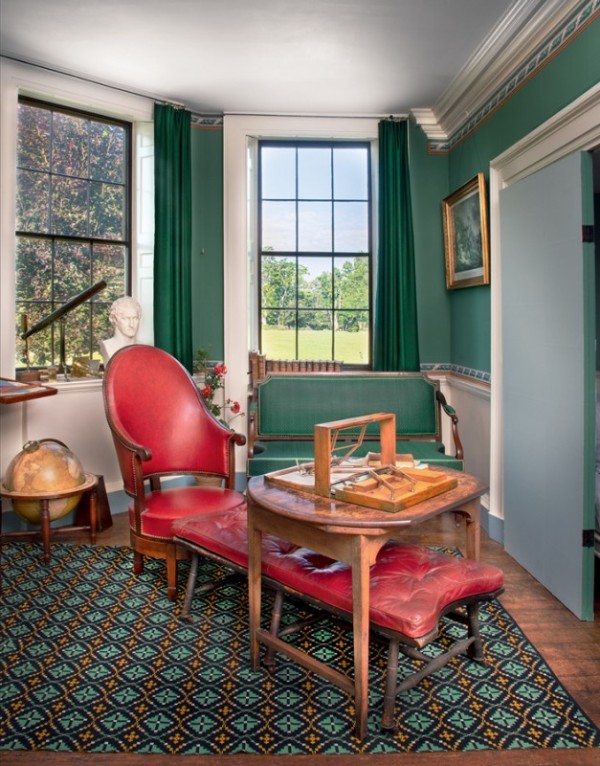
Cabinet, Monticello, Albemarle County, Virginia. (©Thomas Jefferson Foundation at Monticello; photo, Gavin Ashworth.) Burling’s shop made the revolving armchair, revolving stand, sofa, and possibly the frame of the revolving writing table.
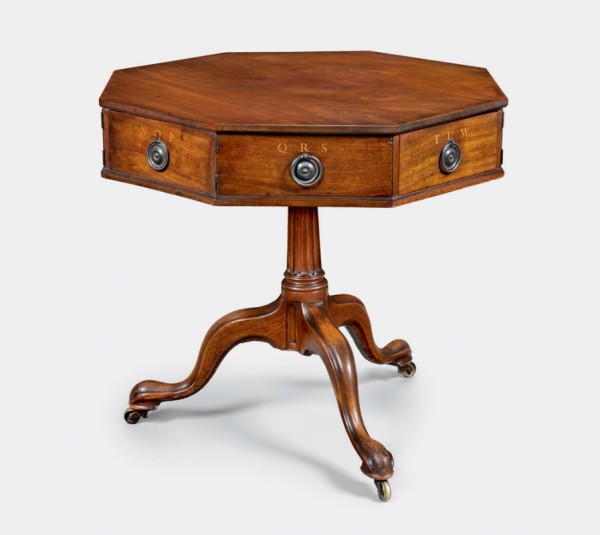
Thomas Burling, writing table, New York City, 1790. Mahogany with tulip poplar. H. 28 3/4", W. 33 1/4", D. 33 1/2". (Collection of the Massachusetts Historical Society; photo, Gavin Ashworth.)
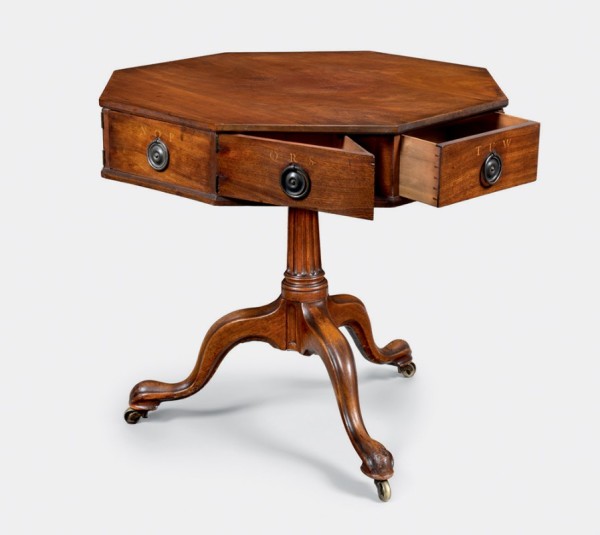
Detail showing the construction and drawers of the writing table illustrated in fig. 44.
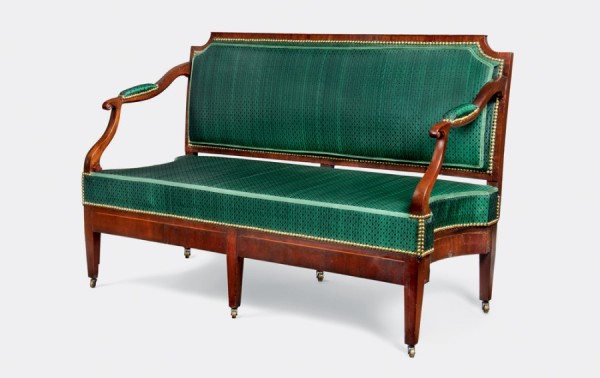
Thomas Burling, sofa, New York City, 1790. Mahogany and mahogany veneer with poplar. H. 38 1/2", W. 57 1/4", D. 27 1/2". (©Thomas Jefferson Foundation at Monticello; photo, Gavin Ashworth.)
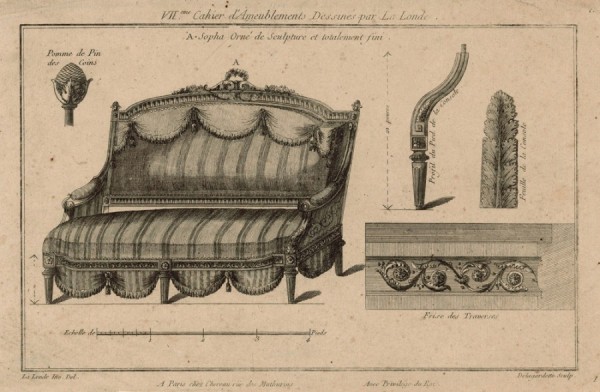
Design for a “Sopha orné de sculpture et totalment fini” illustrated in Richard de La Londe, Oeuvre diverses de LaLonde (1776–1788.), 2: ch. 7. (Courtesy, Rijksmuseum, Amsterdam.)
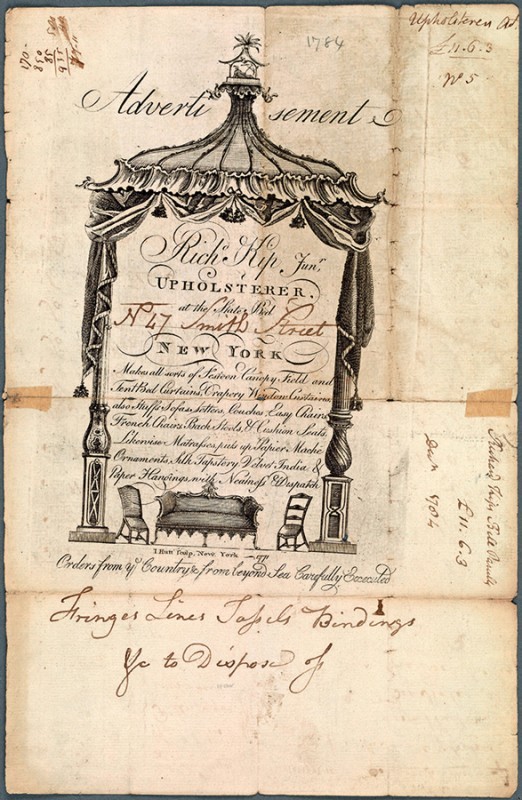
Advertisement for “Richard Kip Jr. Upholsterer,” New York City, ca. 1770. (Courtesy, New York Public Library.)

Windsor armchair, retailed by Richard Kip Jr., New York City, 1786–1790. (Private collection; photo, Winterthur Museum.) Remnants of Kip’s label appear under the seat.
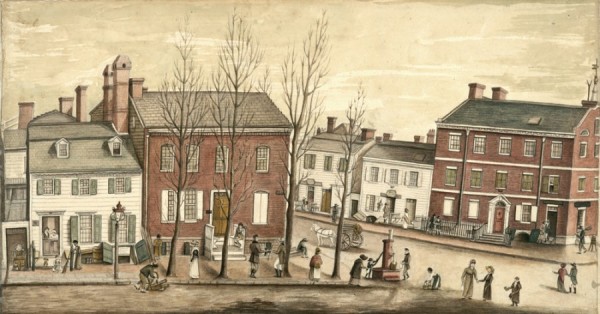
Anne-Marguerite-Henriette Hyde de Neuville, Corner of Greenwich, New York City, 1810. Pen, ink, and watercolor on paper. 7 5/16" x 13". (Courtesy, New York Public Library.)
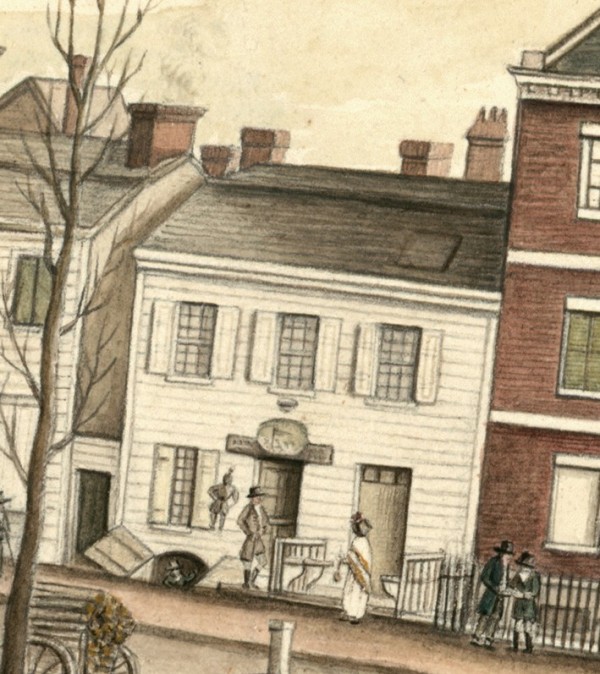
Detail of fig. 50, showing a three-bay house with a side passage like the one shown in Jefferson’s house plan in fig. 52.
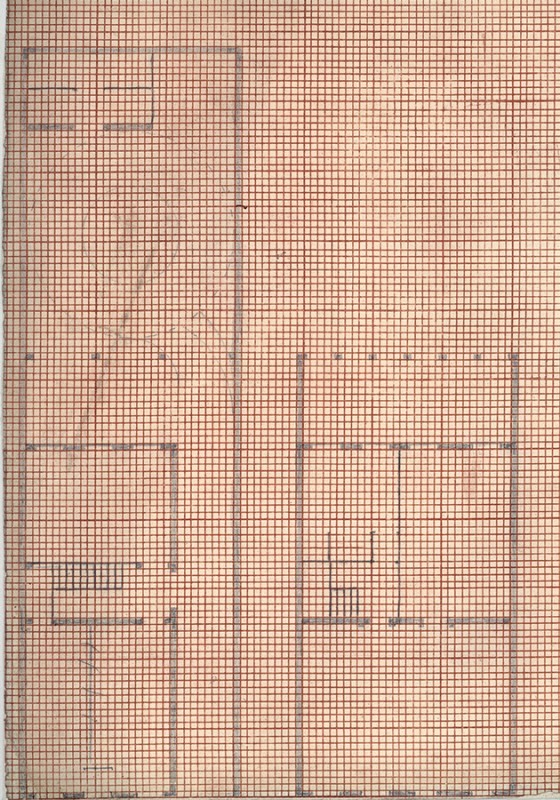
Thomas Jefferson, plan of the first and second floors of 57 Maiden Lane, New York City, 1790. Ink on paper. 9 1/8" x 11 15/16". (Collection of the Massachusetts Historical Society.)
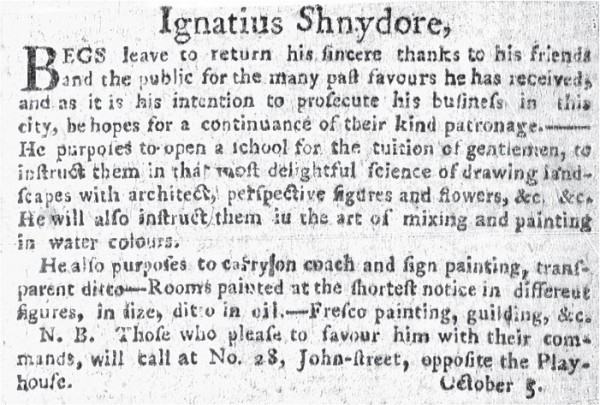
Advertisement for Ignatius Shnydore, Daily Advertiser, Political, Historical and Commercial (New York), October 5, 1789. (Courtesy, NewsBank/Readex.) Shnydore identifies fresco painting as one of his talents.

Two Figures in Roman Costume on Stage at the John Street Theater, New York City, ca. 1800–1850. Wood engraving. Ink on paper. 5 1/2" x 7 1/4". (Courtesy, New York Public Library.) This is a view of a classical play staged ca. 1791. The backdrop may be a representation of Shnydore’s perspective painting.

Library at Monticello, Albemarle County, Virginia. (©Thomas Jefferson Foundation at Monticello; photo, Gavin Ashworth.) Jefferson installed the New York furniture in his private suite.

Mather Brown, Thomas Jefferson, London, 1786. Oil on canvas. 36" x 28". (Courtesy, National Portrait Gallery, Smithsonian Institution.) This painting portrays Jefferson when serving as minister to France.
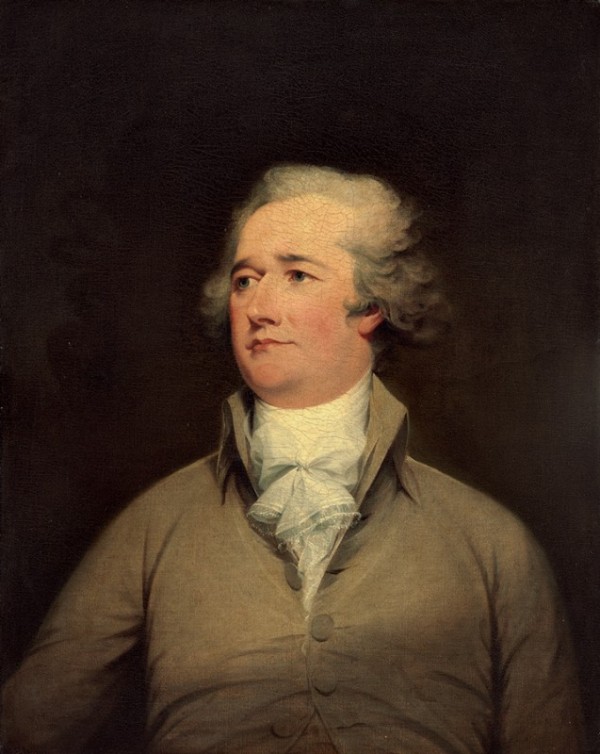
John Trumbull, Alexander Hamilton, New York, 1792. Oil on canvas. 30" x 23 13/16“. (Courtesy, National Gallery of Art.)
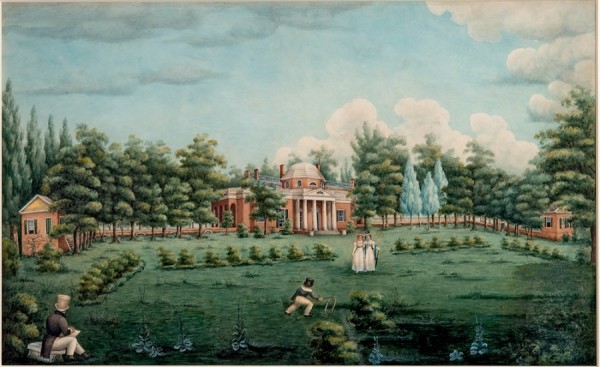
Jane Braddick Petticolas, View of the West Front of Monticello and Gardens, Virginia, 1825. Watercolor on paper. 13 5/8" x 18 1/8". (©Thomas Jefferson Foundation at Monticello.) This presents an idealized view of life at Monticello during the final years of Jefferson’s life.

Parlor at Monticello, Albemarle County, Virginia. (©Thomas Jefferson Foundation at Monticello; photo, Gavin Ashworth.)
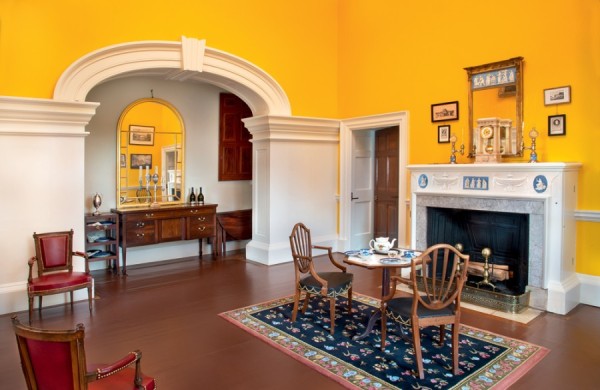
Dining room at Monticello, Albemarle County, Virginia. (©Thomas Jefferson Foundation at Monticello; photo, Gavin Ashworth.)
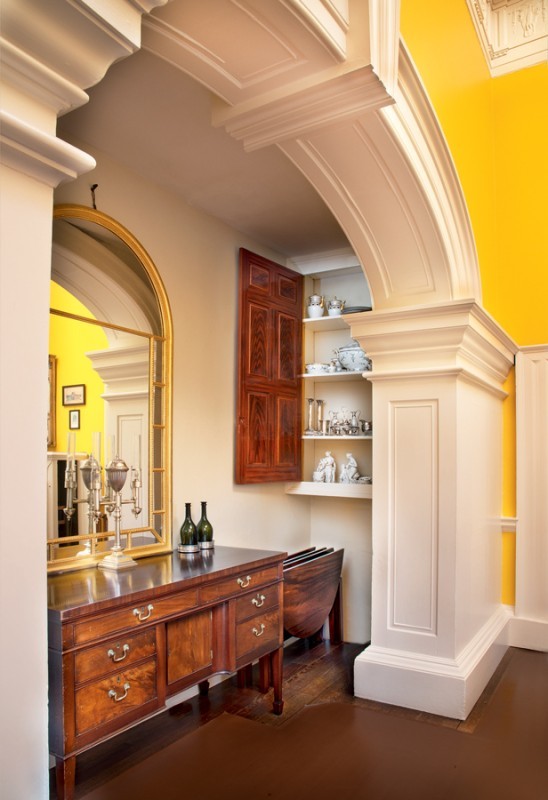
Alcove of the dining room illustrated in fig. 60. (©Thomas Jefferson Foundation at Monticello; photo, Gavin Ashworth.)
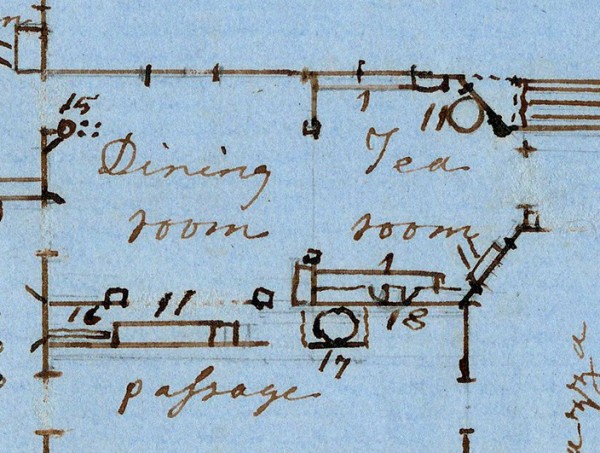
Cornelia Jefferson Randolph, “Plan of the First Floor of Monticello,” ca. 1826. Ink on paper. 8 1/4" x 13". (Courtesy, Albert and Shirley Small Special Collections Library, University of Virginia.) This detail shows how the console, sideboard (no. 11), and dining tables (no. 16) were stored in the dining room alcove.
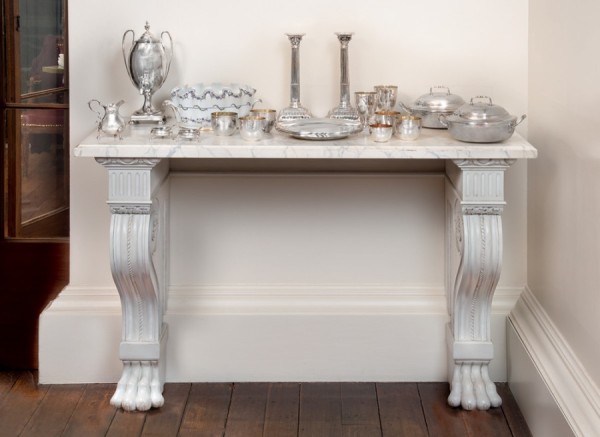
Harrison Higgins Jr., reproduction of a French console table. Richmond, Virginia, 2009. White pine with poplar. H. 34 1/2", W. 50", D. 20". (©Thomas Jefferson Foundation at Monticello; photo, Gavin Ashworth.)
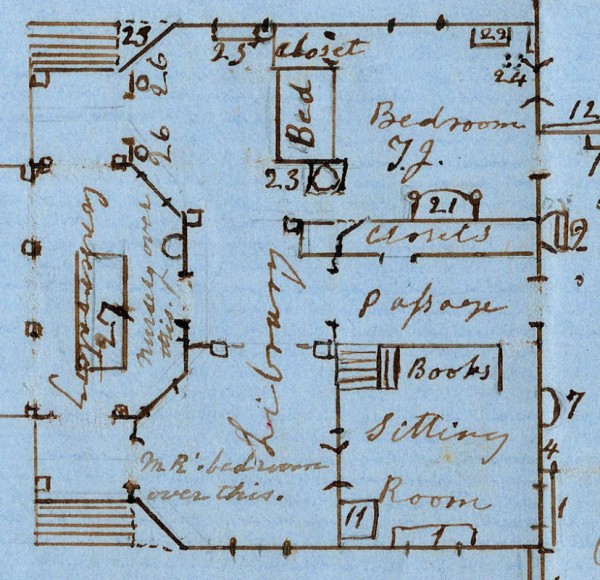
Cornelia Jefferson Randolph, “Plan of the First Floor of Monticello,” ca. 1826. Ink on paper. 8 1/4" x 13". (Courtesy, Albert and Shirley Small Special Collections Library, University of Virginia.) This detail shows the original location of the octagonal writing table surmounted by the square pupitre as well as the overall arrangement of Jefferson’s private suite. The sofa attributed to Burling is no. 25 on the plan, situated in the cabinet.
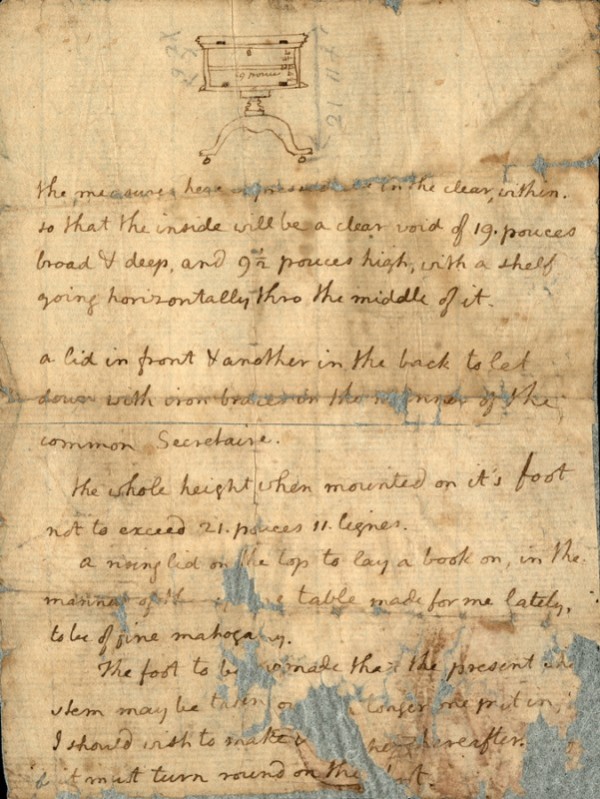
Thomas Jefferson, “Design for a Desk,” Paris, ca. 1785. Pen and ink on paper. 4 1/2" x 6". (Courtesy, Albert and Shirley Small Special Collections Library, University of Virginia.) This is Jefferson’s commission drawing and notes for his pupitre, used to record and store correspondence.
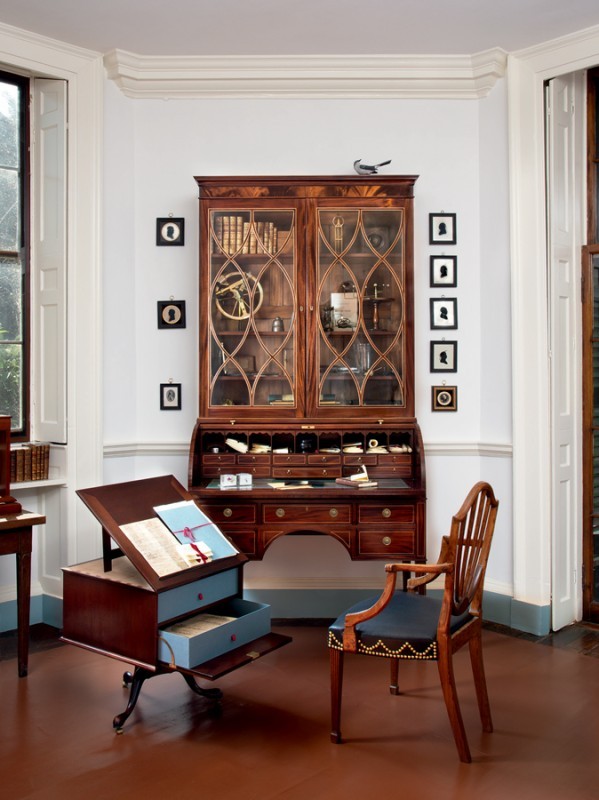
Harrison Higgins Jr., reproduction pupitre, Richmond, Virginia, 2017. Mahogany with tulip poplar. H. 22 3/8", W. 20", D. 20". (©Thomas Jefferson Foundation at Monticello; photo, Gavin Ashworth.) The original object has not been located.
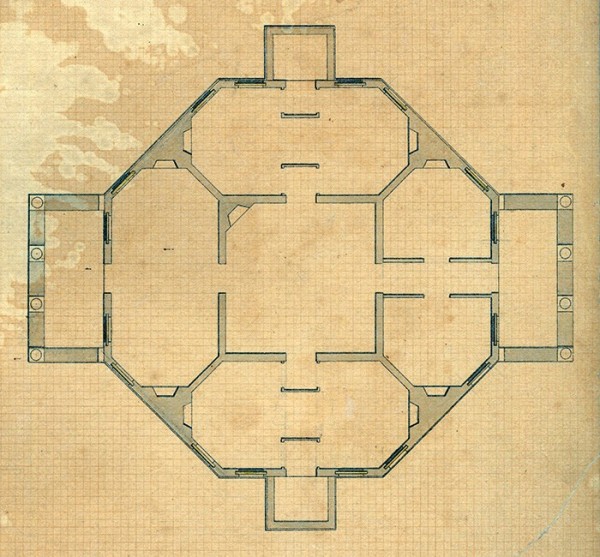
John Neilson, “Plan of Poplar Forest,” Bedford County, Virginia, 1819. India ink on hand-ruled graph paper. 11 1/2" x 9". (Courtesy, Albert and Shirley Small Special Collections Library, University of Virginia.)
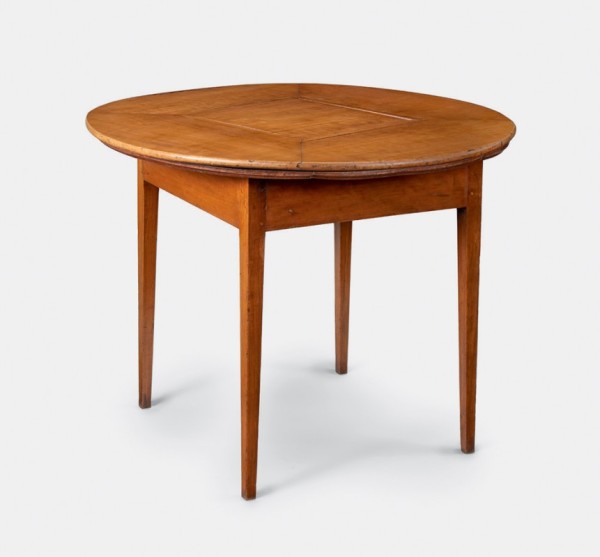
Revolving table, attributed to John Hemmings, Monticello, Albemarle County, Virginia, ca. 1815. Cherry and walnut with yellow pine. H. 28 1/2", D. 35 3/4". The top features an inlaid square in contrasting wood. (©Thomas Jefferson Foundation at Monticello; photo, Gavin Ashworth.)
SURROUNDED BY CRATES and barrels, chairs wrapped in mats, boxes of books, and Virginia hams, Thomas Jefferson drafted a packing list of his furnishings (fig. 1) awaiting shipment from the federal capital of New York City, where he was serving as secretary of state, to the new one of Philadelphia. It was August 31, 1790, and he was surveying the contents of his rented house. Despite both his cramped quarters and the fact that the furnishings of his house in Paris, where he had lived while serving as minister to France, were being shipped to him, Jefferson had been shopping. New evidence reveals that he acquired dining furniture and study or writing furniture from New York City workshops, furnishing what he considered the more important spaces in the house—the dining room, library, and study—and thus ensuring fully functioning rooms outfitted for entertaining and work. It might well have been reasonable for him to acquire furniture to facilitate correspondence and recordkeeping, given his role as a diplomat. However, classifying a suite of dining furniture as a necessity speaks to Jefferson’s masterful use of dining as an essential tool for diplomacy. Indeed, the move that necessitated this packing list was, at least in part, the result of a dinner Jefferson hosted for James Madison and Alexander Hamilton. Jefferson went to great lengths to decorate and furnish essential rooms in his rental home, because the domestic setting is where he preferred to stage political negotiations and to write. Therefore, when the need arose, he had a furnished room ready for him to enact dinner table diplomacy. This room recently has captured the national imagination as “The Room Where it Happens” from the musical Hamilton, outfitted with brand new furniture from New York shops, including side chairs (fig. 2) that are at Monticello today.[1]
When the packing list that Jefferson had drafted that steamy August day surfaced in 2007, it set in motion a years-long project to puzzle out the specifics of the objects and to identify the originals, some of which remained secreted in Monticello’s collection. Essentially the Rosetta Stone for a large group of furniture, this slight document provided significant new facts and clues for what Jefferson acquired during the scant five months he lived in New York. Primary furniture on the packing list includes a sideboard, dining tables, sets of side chairs and armchairs, Pembroke tables, an octagonal writing table, a pair of small sofas that could be disassembled, a revolving chair, a reading stand, and a tambour writing table and bookcase. This essay will analyze the New York packing list, in conjunction with related primary source material, to identify what furniture Jefferson purchased there and from which workshops. It will attribute an entire group of furniture to Thomas Burling, some of which is in the collection at Monticello, and share examples of modern furniture commissioned to stand in for lost New York originals. Finally, this analysis will consider Jefferson’s motivations, both personal and political, for his decisions on how to furnish both his temporary home on Maiden Lane in New York and his plantation home, Monticello, in Albemarle County, Virginia.
Part I: The New York Packing List
Officially identified as Thomas Jefferson’s List of Packages Sent to Philadelphia from New York, 31 August 1790, or simply the New York packing list, the document was unknown to scholars and editors of the Jefferson Papers. It had never been tracked, cataloged, or transcribed. It serves as a finite record of furnishings acquired in New York and readied for shipment to Philadelphia; it also provides evidence of the huge effort by the United States government to physically move all the clerks and secretaries, cabinet members, congressmen, and president, along with the records and furniture, from New York to the new capital city that Jefferson helped establish.[2]
Henry Remsen Jr., chief clerk in the Department of State under Jefferson, oversaw Jefferson’s moving arrangements. An exchange of memoranda outlines plans for the move beginning in late August 1790. Remsen’s memorandum sought guidance regarding Jefferson’s furniture: “Mr. Jefferson will please give H. R. junr. any directions he may chuse [sic] to leave with him, respecting the removal of his furniture to Philadelphia, the payment of the transportation of it there &c.” Jefferson asked him to watch out for his furniture from Paris and have it sent along with the New York lot. The packing and shipping of eighty-six crates took so long to arrive that they were safely redirected to Philadelphia. Jefferson set an arrival deadline of October 25, which he met because on the first and fourteenth of that month he paid for “cartage Mr. Jefferson’s furniture . . . to the wharf.” Within the context of these two memoranda, it is apparent that Jefferson included the New York packing list as an attachment for Remsen. The verso of the list is inscribed by Remsen “Mr. Jefferson’s Directions/August 31. 1790.” The annotation “directions” clarifies that the New York packing list was part of the written instructions Jefferson issued.[3]
The timing of the move and the documentary evidence—including the packing list, memoranda, and account of moving expenses—confirm that the objects on the list were acquired in New York. Because there is no evidence that Jefferson brought furniture from Virginia, and his French furniture had yet to arrive, the contents of the crates and packages had to have been acquired in New York (the hams excepted). This revelatory document lists what furniture types Jefferson purchased, but more importantly it provides invaluable clues as to size, color, and maker of an entire body of work.
Crated Furniture
In composing the list, Thomas Jefferson gave precedence to the crated objects, especially crate numbers one through eight, which contained the most significant examples from his newly acquired furniture collection. Each crate was numbered, supplemented by a brief title, dimensions in inches (arranged in order of width, height, and depth), and the total cubic feet of the crate. The dimensions were key for estimating the size of the original objects. Most of the furniture was crated individually, except for multiple Pembroke tables in crate number two and dining tables in crate number six.
This study began by focusing on crate number seven. Noted only as “chair,” the overall dimensions suggested Jefferson’s tall revolving chair, attributed to Thomas Burling (fig. 41). When faced with a laconic title like “chair,” the dimensions dramatically narrowed the search. It is important to note that when ordering the dimension columns, Jefferson used width x height x depth, rather than the modern practice of placing height first. All the crates had an overall dimension approximately two inches larger than the object within, providing an allowance for packing materials. We do not know who made the New York crates, but they may have looked like the ones illustrated in an eighteenth-century view of a box maker’s workshop published in Diderot and d’Alembert’s Encyclopédie ou Dictionnaire raisonné des sciences, des arts et des métiers (fig. 3).[4]
Flat packing
Jefferson’s care in recording dimensions sometimes offered an invaluable way-finder, as happened with crate five, where the recorded dimensions are just inches larger than the full-sized sideboard it contained. But most of the crates, five out of the eight, had perplexing dimensions that did not seem to comport with the titled contents. Progress stalled until sketches of crate number eight provided a visual cue. Jefferson labeled it “Writing table,” noting the dimensions as 39 x 33 x 7. Initially, the contents appeared to have been a rectangular portable desk, but when is such a desk so improbably wide or tall—or narrow, seven inches or less? By visualizing the shape of the crate while considering that it held a table, it became apparent that the top of Jefferson’s octagonal writing table (fig. 4) fit perfectly within. The overall dimension of the top is thirty-one inches long, and it is six inches deep, making it a secure fit in a crate that is approximately one inch larger. But what of the extra five inches in the width? Why was it thirty-nine inches? The answer proved to be flat packing. The crate contained not only the top, which easily lifts off the base, but the pedestal and three detached legs in the void next to the top (fig. 5).[5]
Knowing that the writing table was disassembled and flat-packed for shipping was a vital breakthrough, providing a methodology for identifying most of the objects on the list. In studying crate dimensions and titles, the list of objects that were shipped flat-packed or partially disassembled include: a tambour writing table with detachable legs; two sofas with detachable backs and with arms and arm supports; a cube-shaped reading stand and base with detached legs; and the writing table. Jefferson as patron would have dictated these features as part of his commission discussions with the cabinetmaker. Why did Jefferson ask for features that cost more in time and expense? Timing suggests that he was eager to create his own versions of the multi-functional and convertible furniture that he saw in Paris. Re-inventing furniture forms with enhanced efficiency and convenience appealed to Jefferson, who embraced the Enlightenment spirit, where reason and observation were the basis for positive change. Furniture that could be shipped flat was both useful and, ideally, cost effective.[6]
Uncrated and Wrapped Seating
The New York packing list includes forty-six chairs, thirty of which were painted Windsor chairs being sent to Monticello. Of those bound for Philadelphia, Jefferson notes “5. pr single chairs. mahogany in mats” as well as “6. arm chairs. do.” Most puzzling are the entries for “1. green stool” making a total of two. None of this seating was crated; instead, it was shipped padded and wrapped in mats, probably made from plaited rushes.[7]
Looking for ways to cut shipping costs, Jefferson consulted with Abigail Adams, who had overseen the packing of her and John’s furnishings when they departed London for America in February 1788. She was nearly overwhelmed by the enormity of it all, writing, “to part with our furniture would be such a loss, & to take it is such a trouble that I am almost like the Animal between the two Bundles of Hay.” And yet she persisted, learning spaceand cost-saving measures in the process. Jefferson shared her advice with his secretary, William Short, who handled closing out Jefferson’s affairs in Paris, and it is useful to quote it at length:
Mrs. Adams tells me that chairs are best packed in open frames made as you have seen crates for earthen ware; only that, for chairs, there need be no middle bars at all. Two chairs are lapped one in the other, the silk being previously covered with coarse linen, then put into these frames and covered over with mats. I have thought however that if two chairs were lapped as beforementioned, and then put into a box, there could be other things packed in the hollows under the bottoms, and thus the chairs be better preserved, and perhaps the packages not cost more on the whole, as otherwise boxes must be made express for the other things. Be so good as to weigh maturely this proposition, with Petit, and do what is best. It concerns the silk chairs and couches only. Those of leather and velours d’Utrecht may come in frames as Mrs. Adams proposes.
Jefferson writes that the set of “single chairs” on the New York packing list were wrapped in mats, and it is likely that both sets of seating were packed in this manner.[8]
Shipping Marks
All the crates, barrels, boxes, and wrapped seating required a visible and easily identifiable owner’s mark to ensure that the shipment arrived in its entirety at the appropriate destination. Thomas Jefferson’s individualized mark, “T. I.,” was painted or branded onto everything he shipped or received. This mark, with variations over time, appears on shipping manifests, invoices, and on a brief list in Jefferson’s own hand. For example, in December 1790 on his list of French furnishings to be shipped to Richmond he notes “T. I. No. 77. A marble pedestal.” There is one unusually rare example of Jefferson’s brand, and it is impressed into the inner surface of the left arm of an armchair sent from France in 1790 (fig. 6). Perhaps perplexed by the mark “T▼J” on the chair, descendants misidentified it as an homage carved by Nicholas Philip Trist upon the death of his grandfather-in-law. “After Mr Jefferson was Confined to his room, the last evening he ever sat up during his last illness this sad a.m. before the chair was moved my father cut the initials ‘T. J.’ on the chair which grandpapa had used the last he ever sat in.” Recent work on branded furniture, with brands of both owners and makers, reinforces the argument that this is a rare example of Jefferson’s shipping mark, probably branded onto this chair when it left France, uncrated but wrapped. This is the only known example of the brand, which may have been limited to the French seating—those pieces have been heavily refinished.[9]
Miscellaneous Items
Household miscellany was sent to Philadelphia along with the furniture. The packing list includes barrels and a hogshead, a box of Jefferson’s, and “two boxes of Mr. Madison’s.” In the middle of this list are stores of food supplies, including a “cash of coffee containing about 100 lb.” In crate number nine, fifty-eight pieces of Virginia bacon and ham filled four barrels and a single box. Jefferson confirmed receipt of these delicacies, noting that “I have received my bacon and venison hams here in good condition, for which I must thank Mrs. Lewis in particular.” The hogshead was packed with “about a gross of empty bottles. 10 bottles cyder.” Box number ten contained “earthen ware. some chine. Candlesticks.” The box of dishes accompanied the “kitchen tables.” The fireplace equipment, “handirons &c.,” was probably rolled inside the mattresses that are listed immediately below. Recorded between the mattresses and kitchen tables are “servants bedsteads.”[10]
Omissions: What Is Not on the List?
Having established that the list encompasses Jefferson’s purchases in New York, there are striking omissions of furniture. Most evident is the lack of bedroom furniture except that noted for the servants, nor bedding. Case furniture, such as a chest of drawers or night table, is absent too. Furniture forms associated with parlors are absent, except for Pembroke tables. Several explanations are possible, such as that the rental house came partially furnished, or more likely, Jefferson rented essentials like his bedstead and bedding from an upholsterer, who traditionally offered that service. Additionally, Jefferson was probably content to make do with a moderately sparse interior, knowing that his French furniture was forthcoming.
New York Craftsmen Patronized by Jefferson
Whom did Jefferson hire to decorate and furnish his rental house in New York? Here, as we have seen, the New York packing list is mute. Before the list came to light, scholars knew that Jefferson bought furniture in New York because craftsmen like Richard Kip Jr. and Thomas Burling appear among his financial records called the Memorandum Books. In these account books, he made brief entries with names, dates, and amounts, seldom providing specifics on what he purchased. Corollary documentation, such as invoices, rarely survives, making specific information about these transactions scarce. Conversely, while the New York packing list provides definitive information on what types of furniture Jefferson bought in the city, it lacks specifics about makers. By comparing these two resources, along with correspondence, floor plans, and recollections of family and visitors, and by studying the objects themselves, it is now possible to make both new identifications and attributions for some of the group. In researching these craftsmen, a significant amount of new information came to light about the furniture trade in New York, as well as the circumstances for Jefferson’s purchases. The Memorandum Books contain entries for five New York craftsmen whom Jefferson patronized: Windsor chair maker Andrew Anderson; cabinetmakers Elbert Anderson (or Alexander Anderson), Thomas Burling, and Samuel Prince Jr.; and upholsterer Richard Kip Jr.
Anderson: Probably Andrew Anderson
On July 16, 1790, Jefferson noted in his Memorandum Book, “Pd. Anderson 2 1/2 doz. green chairs &c. £12-10.” Jefferson was probably trading with Andrew Anderson, a Windsor chair maker active in New York circa 1786–1811. The New York packing list includes a set of green Windsor chairs. In August 1790 Jefferson wrote to James Brown, his factor in Richmond: “I send from hence 2 1/2 doz. Windsor chairs, which I have desired to be delivered to you, and will beg the favor of you to forward them as quick as you can to Mr. Lewis’s or to Monticello.” Given the large size of the set and the moderate cost, they were probably painted bow-back side chairs with baluster shaped legs. Examples of Anderson’s Windsor chairs have not been identified, but Jefferson’s may have resembled those made by the New York shop of John Always and Joseph Hampton (fig. 7).[11]
Anderson: Probably Elbert Anderson, or Possibly Alexander Anderson
Jefferson noted on August 30, 1790, one day before he compiled the New York packing list, that he had paid Thomas Burling for “cabinet work,” followed by an entry to pay “Anderson do. £10.” Jefferson was settling his accounts with two New York cabinetmakers, Burling and, probably, Elbert Anderson. Evidence suggests that this transaction was for the set of six armchairs that appear on the New York packing list. One candidate for their maker is Elbert Anderson, who on February 5, 1788, announced (fig. 8) that “he has lately entered upon his former occupation” and ensuring his “employers” that “He makes plain, circular, inlaid, and carved work of all kinds that belong to the cabinet and chair making business.” In reestablishing his furniture business, Elbert had to compete against more established cabinetmakers like Burling as well as the “auction furniture” market, which apparently relied on misleading claims to make sales. Elbert used the word “circular” as an identifier, an adjective that often appears in Thomas Shearer’s The Cabinet-makers London Book of Prices, as in a “circular pier table.” Elbert may have owned a copy of the book, which was published the same year he returned to the trade. In July of 1788, either Elbert or Alexander Anderson was one of the leaders of the contingent of cabinetmakers in the great parade held “In Honor of the Constitution of the United States.” In addition to the marchers, there was a horse-drawn stage featuring cabinetmakers building a cradle and table, which they finished by the parade’s end. A painted banner with a representation of a furniture wareroom was emblazoned with the motto “Unity with Fortitude.”[12]
The New-York City Directory for 1790 lists Elbert Anderson at 53 Maiden Lane, just steps away from Jefferson’s house. At that time Anderson had a large household, which included four free white males over sixteen, four free white males under sixteen, five white females, and notably, three enslaved workers. Historian Shane White’s study of slavery in eighteenthcentury New York has identified that one in five households in New York City owned at least one enslaved person, and that slave ownership prevailed from the highest to the lowest classes. White further states that the largest group of slaveholders in 1790 (and probably for most of the eighteenth century) was artisans rather than merchants. As a slaveholder and an artisan, Anderson embodied these data, and his holdings exceed one further statistic. White cites that among New York City’s slaveholders, half only owned one enslaved person, but Anderson surpassed that cohort by holding three people in bondage. These unnamed slaves worked for Anderson, and some or all of them were presumably engaged in his cabinetmaking business. Enslaved laborers may have been responsible for parts or entire pieces of the furniture coming out of this workshop. If this supposition is correct, Anderson was attempting to capitalize on the system of enslaved labor by keeping his costs down and his profits high.[13]
Anderson and his workshop produced fine case pieces such as the labeled mahogany secretary-and-bookcase illustrated in figures 9 and 10. The engraved scene on his label features a chest of drawers surmounted by a shield-back side chair with an ornate splat adorned with swags and Prince of Wales feathers. This design was popular in New York, and numerous chairs in this pattern were erroneously attributed to Anderson based on this evidence. Another set of chairs with an Elbert Anderson attribution (fig. 11) belonged to Alexander and Elizabeth Schuyler Hamilton. Derived from plate 11 in Hepplewhite’s The Cabinetmaker and Upholsterer’s Guide, they feature a straight crest and light wood inlay instead of carving. It is probable that Anderson also owned a copy of Hepplewhite’s Guide or had ready access to one.[14]
Given Anderson’s large operation and his prominence as a chair maker, Jefferson’s unspecified purchase, presumably with him, may have been the set of six shield-back armchairs. Three chairs are extant (fig. 12), confirming a New York origin. They are patterned after plate 9 in Hepplewhite’s Guide (fig. 13). The shield back on Jefferson’s chairs is the most striking element, with a foliated-carved lunette from which four fluted and imbricated ribs or banisters extend to the crest rail. The base of the shield is rounded, but the crest is slightly elongated. Serpentine arms terminate in a rosette and rest on attenuated curved supports with molded, not reeded, treatment. The arm supports transition behind front legs that are fluted and tapered, with spade feet.[15]
This design was interpreted widely by New York chair makers but came to be closely associated with Robert Carter, a respected cabinetand chair maker who, like Anderson, was one of the leaders of the great procession in 1788. In 1790 his operation was situated on Fair Street, and his household included six free white men under sixteen and four over, as well as five females and one enslaved worker, who may have labored in his shop. Robert Carter was also Thomas Burling’s brother-in-law and sometime business partner. Because Carter and Burling had both personal and professional ties, and because Jefferson’s chairs resemble Carter’s well-documented commission for Peter Elmendorf as well as examples attributed to Burling (fig. 14), it is possible that either one of them produced Jefferson’s set. However, Jefferson’s financial records strongly suggest that of all the examples on the packing list, the sum paid correlates to the small set of armchairs. Therefore, it is probable that Anderson, probably Elbert and his shop, not Burling or Carter, was responsible for this interpretation of a New York favorite.[16]
An alternative candidate to Elbert is Alexander Anderson, a joiner and cabinetmaker active in New York City as early as 1786. Alexander is listed as a cabinetmaker in the 1790 New York City directory, and he too had a Maiden Lane address. According to the Federal Census, his household included five white males above sixteen, three under sixteen, and four white females, but no enslaved individuals. Alexander’s best documented work was for Charles Thomson, Jefferson’s friend and secretary of the Continental Congress. In 1786 Anderson billed Thomson on three separate occasions (fig. 15) for work that included: making a breakfast table and putting finish on two dining tables, building boxes, “jobs done about the House,” and “putting banisters into chairs.” While this is compelling evidence that Thomson hired him, the type of work provided does not comport with what we know is on the New York packing list. Having two Andersons on Maiden Lane in Jefferson’s daily orbit is problematic, but Elbert Anderson likely made this sale.[17]
After years of service and wear, the set of armchairs was broken up at the Monticello dispersal sale held in January 1827. The executors organized a multi-day sale of Jefferson’s personal estate in order to begin paying off the huge debt he had left his heirs. Records from this sale are scant, but that said, executors were eager to sell furnishings and art from the public rooms, as well as livestock, farm equipment, and nearly all the enslaved workers on the plantation. The furniture from Jefferson’s private suite, however, was withheld from auction. Thomas Jefferson Randolph, grandson and executor for Jefferson’s estate, apparently took some or all of these armchairs to his neighboring home, Edgehill plantation. The surviving chairs stayed there until they were sold in the early twentieth century, with two pieces later entering the Monticello collection.[18]
Burling: Thomas Burling
Thomas Burling was tapped to fulfill most of Jefferson’s furniture commission, the latter visiting the cabinetmaker at his wareroom at 36 Beekman Street “at the Sign of the Chair,” near St. George’s Chapel. George Washington and Jefferson were just two of Burling’s prominent clients, making his workshop the premiere cabinet operation in New York. Jefferson’s 1790 Memorandum Book includes an initial payment to him on July 17: “Pd. Burling cabinet work in part £100.” At the end of the summer, Jefferson noted: “Pd. Burling cabinet work in full £43–12.” These two large payments, taken in consideration with the contents of the packing list, reveal that most of the furniture, not counting the sets of Windsor chairs and mahogany armchairs, came from Burling’s shop.[19]
Burling came from a prosperous family of Quaker tradesmen and landowners in New York City. He trained under Samuel Prince, one of the best cabinetmakers working in the pre-war era. Burling would later use this connection in his advertisements, touting the excellent training he received from Prince. Prince’s rococo-style label states he can be found at “the sign of the chest of draws” on Cart and Horse Street (fig. 16). As his apprentice, Burling would have spent years working in Prince’s shop, and perhaps living with his family. At about the time Burling’s apprenticeship ended, Prince advertised on February 15, 1768, “To be sold cheap, three likely negroes, a man 22 years old, a boy 13, and a wench 14 years. They can all be recommended for their honesty and sobriety. Enquire of Samuel Prince, cabinet maker.” The “likely” enslaved men may have worked in the shop alongside Burling. Such a personal encounter with the inhumanity of forced bondage likely contributed to Burling’s antislavery activism later in life. Evidence of his slaveholding suggests that Prince was not a Quaker. In 1772 he rented workshop space to John Sheybli (fig. 17), an organ builder who also repaired and tuned keyboard instruments. This arrangement may suggest that Prince built some of the cases for his tenant.[20]
Burling confidently entered the cabinetmaking business, which he proudly announced in December 1772: “THOMAS BURLING, Cabinet and Chair-maker, in Chapple-street, New-York, Has opened a yard of all kinds of stuff, suitable for country JOINERS, which proposes to sell on the most reasonable terms.” Eventually, master and apprentice became serious business competitors, with both men vying for customers in the turbulent winter of 1775. That February Samuel Prince informed the public that he took orders for the West Indies, and that “He has now on Hand for SALE case work in the best mahogany, as well as an assortment of chairs.” On March 16 Burling stepped up and placed ads in two newspapers, one illustrated with an eye-catching image of a ribbon-back mahogany side chair (fig. 18). He informed the public that he too had furniture on hand, emphasizing that it was “made of the best mahogany, which he proposes to sell as cheap as any man in this city.” Burling also promoted his “Mahogany Yard,” where he sold lumber to the trades—a product line that Prince did not offer. The timing suggests that both men were experiencing economic uncertainty concomitant with the political unrest that descended into armed conflict in April 1775. During the war years, both shops closed operation, with Burling and Prince and their families leaving the city. Prince died in 1778, leaving the cabinetmaking field open for Burling once the war ended.[21]
After a tumultuous five years, Burling announced the reopening of his business on January 10, 1785, announcing that “He has returned to this city, and resumed his former calling, at the sign of the Chair, near the Chapel, on Beekman street.” He stated that he was hiring the best workmen, that he trained under the best cabinetmaker, Samuel Prince, and that he had a stock of mahogany and other furniture, and the wood itself, for sale. By November 1786, he announced the opening of a wareroom (fig. 19) “for the convenience of strangers, and others, who may resort to settle in this city.” Burling offered a wide selection to relieve the out-of-towners from having to purchase “new furniture at these public vendues.” Prince the elder was no longer competition, but Burling now had to contend with the auction system, where groups of new furniture could be sold quickly and cheaply. Burling may have been referencing Frederick Jay when he set about to challenge the auction business. Jay is described as a “vendue master” in the New York directory. On October 26, 1786, Jay announced his upcoming auction of “a large variety of elegant Household Furniture” including “mahogany dining chairs and breakfast tables, sideboards, and more.” The consignor or source of the furniture is not listed, but this type of auction undercut cabinetand chair makers’ business. Burling’s solution was to adopt the wareroom system, meaning more space, more risk with stock on speculation, and more craftsmen to pay, all to lure customers away from the auctions. He introduced a wider variety in his offerings, as suggested by the image of a bow-back Windsor armchair he selected for this advertisement. The “other furniture” available could have been Windsor seating. Burling’s wareroom apparently had something for everyone. The auction market remained an issue as late as 1788, when Elbert Anderson publicized his wares as a sound alternative to those sold at vendue (fig. 8).[22]
By 1790 Burling’s wareroom operation was a success, with sales surpassing one hundred pieces of furniture to the federal government for the president’s house in just one exchange. However, to fulfill the huge demand, Burling supplemented his own shop’s output by selling furniture imported from Philadelphia. He retained this success despite a near-catastrophic blaze on the night of January 1, 1789, when “a fire was discovered in a chamber occupied as a work-shop in the house of Mr. Burling, Cabinet-maker, Beekman street; the chamber with its contents was nearly destroyed.” One correspondent noted that “Five young lads who slept in the upper story with difficulty escaped from thence into the street by means of a bed cord.” It is interesting to note that there were rope beds upstairs, and that the five young men may have been apprentices. One of the lads could have been cabinetmaker William Whitehead, who recounted that when he was about twelve years old and newly arrived from St. Croix, he apprenticed himself to Burling in circa 1785. On January 16, Burling thanked his neighbors for their help, assuring them “that altho’ I met with a loss, and was a few days deprived of pursuing my Business, yet I suffered to little of my STOCK of MAHOGANY and READY MADE FURNITURE, that I am again enabled to resume my Business as usual.” Business was so good that by November 1789 Burling could advertise that he had “lately employed an additional number of workmen, that he might be the better enabled to accommodate strangers ” Some of these workers may have been among the seven white males over the age of sixteen (but no enslaved persons) who are listed as part of the Burling’s household on the 1790 Federal Census.[23]
Unlike his competitor Elbert Anderson, his teacher Samuel Prince, and his in-law Robert Carter, Burling did not rely on enslaved labor either at home or in his workshop. On the contrary, he aligned himself with the antislavery movement, becoming a member of the New-York Society for Promoting the Manumission of Slaves. Furthermore, Burling’s enterprise included at least one person of color, presumably a free man: “William Miller, a coloured man, who has been in the family of Thomas Burling & Son upwards of Sixteen years, was ordained to the work of the ministry.” This ordination took place in 1808, but prior to the ministry, Miller probably worked for or had been “in the family” of the Burling and Son cabinet shop that was formed in 1791. In addition to Burling’s sons Samuel, William, and Ebenezer, the patriarch may have also trained William Miller. One wonders what Thomas Burling, the antislavery activist and Quaker, thought of his elite customers from Virginia and New York City who were slaveholders.[24]
Burling did not just make and sell mahogany furniture; he was also active in the trade of mahogany, the highly desirable wood harvested in the Caribbean and Central America. Burling needed a large supply of imported mahogany, the wood most popular with his clientele, for his extensive furniture operation,. He stocked it for his own output and he also sold it to other cabinetmakers and carpenters. In doing so, Burling participated in a system that relied on the labor of enslaved workers to manage, harvest, process, and ship mahogany to points in the Atlantic world. Timber sent from the forested land claims in Central America was harvested by enslaved laborers working under extreme hardship and dangerous conditions. Burling and his peers certainly knew of the ties between slavery and the mahogany trade, but his market demanded this exotic import despite the human cost. This conflict of personal and professional ideology probably troubled Burling, yet mahogany remained the mainstay material of his shop.[25]
The furniture itemized on the New York packing list is overwhelmingly mahogany, except for the walnut reading stand, painted Windsor chairs, and servants’ bedsteads. There are a few reasons for Jefferson’s choice of mahogany. First, as scholar Ann Smart Martin has shown, mahogany, with its “warm rolling effects,” was a luxury wood and a status symbol, even in trend-setting France, where furniture in the English style was popular. Secondly, Jefferson had already collected a substantial group of mahogany furniture in Paris, mostly tables (fig. 20). A trestle table (fig. 21) with marble top and a mahogany base, is so Anglo-looking that it was formerly assigned a Philadelphia origin. Exemplifying Anglomania in France, this trestle table was made in Paris but in the English style. Jefferson frequently contracted with cabinetand chair maker Jacques Upton, and it is possible that Upton (an Anglo-Irish surname) was British. If this is the case, he would have been well suited to provide Jefferson with mahogany furniture in the English manner. A third reason for Jefferson’s choice is that he was surprisingly knowledgeable about mahogany, which would have been invaluable in an era when quality stock was not always so readily available. In his written commission for two desks from a London shop in 1789, he specified “the fineness of the mahogany to be more attended to than the price. The French spotted mahogany is the handsomest if to be had.” One of these desks survives (fig. 22), and it has a large single-board mahogany top, but not the Acajou moucheté or streaked plum pudding mahogany he hoped for. Jefferson’s appreciation of mahogany, which he used architecturally as well as for furniture, is borne out by how often he mentions it in his letters and reports—upwards of fifty times, far more than Washington, Adams, and Hamilton combined. Finally, the New York furniture aesthetic probably appealed to Jefferson, who was progressive when it came to improved functionality but tended toward the traditional in his aesthetic choices at this time. New York furniture, with its rather solid appearance and its celebration of clean-lined mahogany, may have been just what Jefferson wanted.[26]
Jefferson spent approximately £143 for all of the furniture from Burling, but what was he charged for individual objects and hardware? In April 1789 Burling sold a large group of mahogany furniture intended for the president’s house, and the surviving account of this sale offers helpful cost parallels. Some charges offer a one-to-one correlation: a fine sideboard cost £19; a large set of dining tables, £25; two sofas, £12; and “10 Mahogany Carved Chairs—£21.” Locks, castors, and the threaded hardware needed for detachable legs were an additional expense. Burling charged separately for “Brass Castors for the Sophay & Easy chair 3/15.” As many as thirty castors were required for Jefferson’s order.[27]
Stylistic evidence from the furniture noted on the New York packing list suggests that Thomas Burling owned a copy of George Hepplewhite’s Guide, either the 1788 or 1789 edition. When assessing surviving original furniture or comparable examples of the lost originals, Hepplewhite was and remains a major design resource. Furniture derived from this design book include side chairs and armchairs based on plates 5 and 9, a tambour writing table and bookcase based on plates 61 and 69, and a Duchesse seating arrangement from plate 28 (fig. 23). The sofa on plate 25 as well as the patterns for window stools and sideboard with innovative lead-lined drawers also relate to Jefferson’s group. Without an inventory of Burling’s shop, it cannot be confirmed, but his extant work suggests a connection between his shop’s output and Hepplewhite’s examplars.[28]
The New York packing list furniture that is attributed to Thomas Burling can be sorted into two groups: stock objects from his wareroom, and special commissions. The survey of this furniture below follows this paradigm, starting with furniture that was standard stock available in the wareroom, followed by furniture Burling produced in collaboration with his patron, Thomas Jefferson.
Wareroom Furniture Attributed to Thomas Burling’s Shop
The sideboard, the set of ten side chairs, and possibly the two Pembroke tables were wareroom stock. The type of sideboard that Jefferson owned appears to have been one of Burling’s standards, with three related examples extant. All are labeled, which also suggests they were stock in trade. The side chairs sold in pairs recorded on the packing list strongly suggest that there was a cache from which to choose. Little is known about the Pembroke tables, but this type of table was commonly available, and so those pieces are included here as wareroom selections. A succession of sleuths has searched for the sideboard, which was sold at the Monticello dispersal sale, but their efforts were hobbled by not having specifics about the piece. To make things more confusing, the quest for the lost sideboard caught the public’s imagination, so nearly fifty people have come forward claiming to have the original. The packing list evidence has finally pinpointed New York as the origin and Burling as the probable maker, and this provided enough evidence for Monticello to commission a reproduction (fig. 24).[29]
Jefferson helpfully titled crate five, “N°. 5. Side board.” The dimensions, which invert width and height, are “64. I. 42. I. 32. I.,” resulting in fifty cubic feet of crate. Knowing that the sideboard was relatively short in width eliminated grand examples of six feet of more, suggesting an object about 60 inches wide. The crate size and shape fit the normal proportions of a sideboard, eliminating flat packing. A search for Burling sideboards in this smaller size has yielded two or three comparable examples, all bearing Burling labels (figs. 25, 26). The sideboard shown in figure 25 is 38 1/2" high, 61 1/2" wide, and 27 1/2" deep, which would fit exactly into crate five with three inches of packing. Made of mahogany with tulip poplar and white pine, the case has a tripartite arrangement with deep faux drawers and real ones flanking a central cupboard. A pair of narrow drawers for linen sits directly beneath the top. The sideboard has tapered legs, spade feet, and brass hardware, but much of its aesthetic appeal comes from its figured mahogany. While not based on a specific design in Hepplewhite, this piece shares the refined simplicity of line with the functional innovations suggested for sideboards with drawers.[30]
Jefferson must have liked his new sideboard, because he used it in Philadelphia and later built an alcove in the dining room at Monticello to accommodate it. The sideboard appears on a plan of furnishings of the first floor of Monticello, and it is documented as being sold at the dispersal sale, when a young man named David Lacy promised to pay $31.50, due June 15, 1827. There is no evidence that he paid the debt, so it is possible that Thomas Jeff erson Randolph as executor took it to his home, Edgehill, later to be sold or claimed by a Jefferson descendant.[31]
Spared by the family from the dispersal sale, the entire set of New York side chairs has been returned to the dining and tea rooms at Monticello (fig. 27). They are recorded on the packing list as “5. pr single chairs. mahogany in mats.” Jefferson probably purchased this seating ready-made, in time for the momentous compromise dinner he hosted in June 1790. As previously discussed, these chairs are based on a Hepplewhite design. They feature a shield back that is slightly elongated terminating in a point, with a double-bead profile. The elongated shield sets them apart from Jefferson’s set attributed to Anderson. There is a tripartite splat with acanthus buds and tendrils centered by a quarter-round lunette with acanthus carving. The molded and tapered legs are reinforced with an H-shaped medial stretcher, plus one between the rear legs, and the chairs were covered in leather upholstery with decorative nailing. A second upholstery campaign, replicating the original nail pattern, is attributed to enslaved cabinetmaker John Hemmings. Archaeological evidence from the Monticello joiner’s shop includes twenty copper alloy upholstery tacks from the Jefferson era, with an additional twenty-one examples found in the north yard.[32]
The final examples of mahogany furniture from Burling’s wareroom may have been in crate two, marked “N°. 2. Pembroke tables. 36. I. 24. I. 31. I. 15 1/2 cub. feet.” Jefferson’s use of the plural “tables” and the crate dimensions suggest two examples, quite possibly a pair. Neither survives, at least in its entirety. The tables were probably nested with the legs facing each other. Jefferson recommended this arrangement for a pair of tables he ordered in 1789, “the small table to be put into the large one, both wrapped up in green bays, put into a tight box and that tied over with oil cloth.”[33]
The Pembroke tables remain an elusive mystery among the crated furniture. Neither table survives, and there is little evidence to suggest what they looked like or how Jefferson intended to use them. They could have been special orders, precursors to the Pembroke tables (fig. 28) made at Monticello for use at Jefferson’s retreat, Poplar Forest. This latter set of tables was designed to be used in tandem with the set of New York dining tables. Given that all traces of them are lost, it is possible they served as fodder for other projects. In 1801 Jefferson asked cabinetmaker Henry Ingle to alter a mahogany table by cutting it down. Ingle determined that his estimate was low so he wrote “I shall forbear cutting it until I hear further from you.”
One possibility is that one of the Pembrokes was reworked or cannibalized to create Jefferson’s unique writing table (fig. 29), which he later paired with the revolving chair and Windsor bench. The reworked table, or parts of it, is attributed to the joiner’s shop at Monticello. It has a circular revolving top with two clipped sides to allow it to fit close to the sitter. If this table started life as a Pembroke, then the base has been re-oriented to allow the depth to become the width. The base lacks evidence that it had a drawer, which is also like the tables for Poplar Forest (fig. 28). The side rails have a semicircular cut to make room for the bench and the sitter’s legs. The table has been fitted with casters to facilitate its movement over the bench. The base is H. 27", W. 22", D. 19", making it a good fit within crate two along with its mate. This writing table is in the cabinet at Monticello, part of Jefferson’s iconic writing group.[34]
Commissioned Furniture Attributed to Thomas Burling’s Shop
Jefferson gave his specially designed reading stand (fig. 30) pride of place on the New York packing list, noting, “N°. 1. paper press. 26. I. cube 10 cub.” Once thought to be the work of Monticello joiners, the packing list dimensions suggest that this “press,” or reading stand with lecterns, was made in New York. The form is essentially a simple walnut box with five lecterns, one at the top and four at the sides, and a base consisting of a pillar and three cabriole legs. The use of walnut is unique within the New York group, which raises the question of why not mahogany? Perhaps with this commission the emphasis was on functionality over aesthetics. After all, when in use it would be heavily obscured by papers. Could this choice be a cost-saving measure? With no documentary evidence that this stand was copied, it is probable that the top part of the reading stand, while atypical, is from New York, but the base is a replacement. When the top is closed it measures H. 11", W. 13 3/4", D. 14 1/4", nearly a cube. When the five lecterns or wings are open, the overall dimensions are H. 21", W. 29", D. 29". It is significant that Jefferson emphasized that the crate is cube-shaped, signaling its similarly shaped contents (fig. 31). This marvel of packing would only have been possible if the base was disassembled and flat-packed alongside the top. The three S-curved legs easily fit, but the telescoping shaft may have been packed into a larger crate.
Jefferson’s designation “paper press” is misleading, suggesting a cupboard or a screw press; this is because he frequently used the word “press” as shorthand for a thing to hold things. Broadly modeled after plate 51 in Hepplewhite’s Guide, which illustrates designs for reading desks with a similar telescoping feature and a support structure for a lectern, Jefferson’s redesign included five lecterns. This was a unique interpretation as well as an overlooked invention. Multiple lecterns on a revolving base offered Jefferson easy access to numerous documents without shuffling papers or leaving his seat. The telescoping feature meant that he could work both standing and seated, and when lowered, the stand could function as a writing table. Typically this object sat next to the revolving chair when Jefferson was writing. Grandson Thomas Jefferson Randolph saved the reading stand for himself. In 1887 the reporter Frank Stockton stayed with the Randolph family, where he was invited to use the stand. He was delighted with the object’s functionality, “a small table with four curious wings, which can be spread out at the sides to hold books of reference, that was used by Mr. Jefferson as a writing-stand, and on which yet remain some blots of ink which declared their independence of his pen.” The family kept the reading stand, sans its base, until the Thomas Jefferson Memorial Foundation acquired it in 1938.[35]
Crates three and four contained a two-part tambour writing table and bookcase, a monumental and costly object that has yet to be located. Jefferson maddeningly titled the contents as “N°. 3. Press. under part. 57. I. 26. I. 27. I. 23 3/4 cub. feet” and “N°. 4. upper part. 58. I. 56. I. 18. I. 34 1/2 cub. feet.” As with the reading stand, Jefferson used “press” in an imprecise way. Without a clear title, the crate dimensions became key to identifying these objects. Starting with crate four, the “upper part” verbiage indicated a two-part object, with the top portion being somewhat less than W. 58", H. 56", D. 18". The height, and particularly the narrow depth, of the “press” suggested a bookcase intended to sit on top of a desk.
Having identified the “upper” bookcase, the “under part” in crate three was almost certainly a desk. At W. 57", H. 26", D. 27", the width and depth suggested a base wide enough to hold the bookcase. But what kind of desk is a mere two feet tall? This lack of height can only be accounted for if, like the reading stand and writing table, it was flat-packed. Flat-packing the base of a monumental piece of case furniture sounds unlikely unless it was designed and constructed in the French manner, with hardware that enabled the legs to be unscrewed and removed. Jefferson was familiar with this innovation, having seen it in Paris, where the specialized desks and tables (fig. 32) pioneered by the master cabinetmakers Abraham and David Roentgen were on show. Jefferson saw Roentgen’s work, as well as examples by other talented cabinetmakers, at Versailles, in the homes of friends, and in the luxury shops on the rue St. Honoré and at the Palais-Royale. Jefferson could not step into a wareroom in New York and buy a secretary bookcase with detachable legs; such a feature was rare, if not unheard of, in American cabinet shops. He would have had to specially request that the desk portion be constructed in this manner, and then the shop would have had to adapt their existing design and either source the necessary hardware or devise a screw-and-nut system to fit into the legs.[36]
Dimensions for the desk portion, which are wide and deep but not tall, indicate that Jefferson acquired a bureau à cylindre or a rolltop desk on legs. In the 1770s the Roentgens perfected desks like this, adding self-acting drawers, multi-functionality, and removable parts for ease of shipping (fig. 33). Parisian cabinetmakers and sales rooms marketed rolltop desks as ideal for a gentleman’s study. These desks were status objects, featuring wooden cylinder or tambour lids, equally both demanding and costly to execute. The innovative fauteuil de cabinet or revolving office chair was designed to make writing while seated comfortable, but also to serve as a handsome and exclusive accessory. The fifth Duke of Devonshire’s revolving office chair and bureau desk (fig. 34) are at Chatsworth House in England, courtly objects to delight the owner and impress the viewer. This set is akin to what Jefferson saw but could not afford to acquire when in Europe. It is this pairing that he sought to re-create as part of his Burling commission.[37]
It speaks to the cosmopolitan milieu in New York that Thomas Burling was already familiar with this power grouping, both the French aesthetics and the mechanics of it. Prior to the Jefferson commission, he made a cylinder rolltop desk (fig. 35) and office or “uncommon chair” for Washington, the exact grouping favored by European aristocrats and kings. Jefferson would have seen Burling’s freshman effort, likely taking mental or actual notes on what he would improve. The desk is modeled after the high-style version of a rolltop, which has a superstructure of drawers added to the top. Burling had the correct elements in place for his costly tour de force, but the result is poorly proportioned and overly massive. It is interesting to note that the original legs were lost, suggesting that they were made to be detached in the French manner. For design sources, Burling may have seen an imported French example, perhaps at the home of the comte de Moustier, French minister to the United States, who brought furniture with him on his mission to New York.[38]
Jefferson’s secretary and bookcase probably hewed closely to Hepplewhite’s interpretation of this form, particularly the “tambour writing table and bookcase” illustrated on plate 69 (fig. 36) in the Guide. Gentlemen in Britain and America favored this two-part design, which provided ample storage for documents, books, writing implements, and valuables. The French seldom paired a bookcase with a rolltop desk, instead reserving the top of the desk for a clock or lighting. Hepplewhite’s Guide does not provide instructions for detachable legs, but the sketch for the tambour writing table shows a bead molding at the base of the case. This treatment appears on French examples, creating a finished effect where the leg meets the case. Having previously determined the size and appearance of the original sideboard, the designs for tambour writing tables, which have a similar aesthetic, served as models for a modern reproduction. Burling charged £21 for a standard “Mahogany Desk & book case,” but Jefferson’s updated version certainly cost more, taking up the largest portion of the £143.12 total bill.[39]
Why would Jefferson order a new writing table and a secretary and bookcase from Burling when he was already better outfitted in that regard than most? In addition to his French writing furniture and the London writing tables, back at Monticello there was a monumental library bookcase and a mahogany standing desk (fig. 37). Scholar Dena Goodman has shown that the bureau form that Jefferson and Washington chose “was the mark of a man who had moved up in the world.” The design evolved from a flat-surfaced table to “a more complicated piece of furniture that included storage of business papers.” This was a classic choice for men engaged in public affairs or business, ones who valued the added storage, locking features, and impressive profile. Some examples also feature pull-out writing surfaces where a secretary could work alongside. A luxury of the highest order, Jefferson indulged himself when he purchased this object, making a statement about his importance in the world, while gaining a controlled locus to write and store his personal letters—and perhaps, the sentimental tokens of a highly private man.[40]
Fortunately, the clues on the packing list and in the will of a Jefferson descendant confirm that such an object existed, and with the evidence gleaned from other New York case pieces, there was enough information to commission a reproduction tambour writing table and bookcase (fig. 38). Conversations with furniture specialists confirmed that flat-packing was used, made possible because of detachable legs and crate dimensions that were overly wide to provide space for padding and the separated components. The reproduction is H. 91 15/16", W. 44 1/4", D. 24", which was in part determined by wall space in the library where the original was later installed. Unlike the revolving chair, the tambour writing table and bookcase have never become closely associated with Jefferson in the minds of the public, probably because the latter lacked the ingenious features that his boosters chose to emphasize. After Jefferson’s death, the piece was moved to his grandson’s home, Edgehill; the last time it is mentioned is in a family will proved in Albemarle County, Virginia, in 1902.[41]
A pair of unique tables (fig. 39) is all that remains of a group of seven commissioned by Jefferson. The packing list states dining tables, plural, “N°. 6. Dining tables 58. I. 33. I. 26. I 31. cub. Feet.” The tables have elliptical ends and are pointedly plain, with straight tapered legs and oversized leaves. When closed a single table measures H. 29", W. 52", D. 4 3/8". The set features exceedingly narrow tops measuring four inches wide, ensuring that all seven tables could fit into crate six despite its being a mere twenty-six inches deep. With this new information, the set of seven dining tables has been re-attributed to Thomas Burling and his workshop.[42]
Jefferson was enamored with useful objects and new ideas. Nicholas Trist, Jefferson’s grandson-in-law, described him as an “economist of space” who sought to utilize space and time efficiently, making that economical approach “his Method of Life.” Trist was both mythmaking and being truthful about his patriarch’s limitless interest in improved systems and objects. To that end, Jefferson collected useful information wherever he encountered it, creating sketches and details for later reference. The ensuing projects were rarely his invention, but rather thoughtful adaptations. One example of his method is found in a memorandum from his 1788 trip to Holland, where he sketched a space-saving table (fig. 40) that, when closed, barely measured four inches deep. This note later served as the inspiration for these dining tables. It is possible that Jefferson shared this sketch with Burling when discussing the order.[43]
The construction of the end sections is unique among American tables. Each section has two stationary legs and three fly legs; the stationary ones are attached at the ends of the primary structural rail, one fly leg extends ninety degrees to support the elliptical drop leaf, and two fly legs extend to support the rectangular leaf. When the leaves of each end are folded down, each section is approximately four inches deep. Mortises cut into the edge of the rectangular leaf of one section, and tenons on the other, indicate the ends were joined to other table sections, and the dimensions of the crate indicate that they were similar forms, albeit with all rectangular leaves.[44]
Jefferson eventually used the design, proportions, and scale of the dining tables as a template for a set of Pembroke tables (fig. 28) that Monticello joiners James Dinsmore and John Hemmings made for Poplar Forest. These tables have a plain, almost severe aesthetic, and unusually, they lack drawers. This feature would have interfered with their functionality as units working with the dining tables. These later Pembroke tables were added to the mix of dining table options first established in there 1790, to be used in conjunction with the original set of seven dining tables. Furniture conservator Robert Self ’s essay on these Pembroke tables notes that the New York dining tables were still at Monticello in 1815, appearing on the tax declaration as “5. Single & 2 double leaved dining tables.” The missing single leaves were “supported by bases having two stationary legs and one swing leg.” The combination of singleand double-leaved tables offered options when setting up for dining. The attention to detail that Jefferson lavished on these tables shows his interest in geometry and his delight in applying mathematics to everyday objects, turning table placement into a mathematical exercise.[45]
Once set up, it becomes apparent how severely plain the tables are—a forest of legs with only figured mahogany for aesthetic appeal. The form may have come from Holland, but the aesthetic is French. According to scholar Kathryn Norberg, “French dining rooms were traditionally rather ad hoc affairs, located (as at Versailles) in an anteroom and bare of furniture save for a folding table.” And unlike English gentlemen who lingered at the table after dinner, making it a suitable object for show, the French, both men and women, retired to the comfort of the salon. When dining at Monticello, the tablecloth was removed after the second course, revealing the varied rectangles and elliptical ends for the guests to ponder.[46]
Of such importance and expense, Jefferson’s new revolving chair (fig. 41) was crated, not shipped in mats like other seating on the New York packing list: “N°. 7. Chair 56. I. 29. I. 29. I. 26 1/4 cub. Feet.” Derived from a French fauteuil de cabinet or office chair, it was a form used exclusively by gentlemen when writing. Revolving furniture, be it seating or tables, appears mundane to modern eyes, but patrons in the eighteenth century would have delighted in this practical innovation of activating the object instead of the sitter. New forms like the office chair are what scholar Mimi Hellman has identified as examples of “a vast battery of small props.” Thus, it was not a given that consumers, including Jefferson, were sophisticated enough to know how to perform or interact with the latest revolving and gliding furniture. Hellman argues that “elite leisure was a social spectacle based on continuous engagement with complicated things.” It was easy to put a foot wrong, but Jefferson enthusiastically embraced this new form of seating, along with a host of innovative furniture, much of which he tasked Burling to create.[47]
Jefferson’s revolving chair follows the accepted formula by retaining the overall form with its circular base and rotating seat and features leather upholstery, armrests that are set back from the front rail, tapered mahogany legs, and spade feet with casters. The circular seat offers the comfortable leg support needed for prolonged sitting, and the set-back of the arm supports ensures that the chair can be pulled up close to the writing surface. Unfortunately, the handholds were later drilled to receive brass candle arms, an implausible addition that would make it difficult to get up from the chair. Conservator Carey Howlett recently reupholstered the chair in red Morocco leather, replicating the French box edge on the back and the box seat. The most noticeable and surprising change that Jefferson asked for was to have the back substantially taller than the French prototype (fig. 34). With its impressive stature and crimson upholstery, Jefferson’s office chair was akin to a personal chair of state used by royalty or the elected officeholders at Federal Hall in New York. Burling probably had made the impressive and commodious speaker’s chair (fig. 42) the year before. If asked why his chair appeared so stately, Jefferson might have demurred, noting that the added height was intended to prevent drafts.[48]
Jefferson favored this chair above all others, celebrating its convenience and, perhaps, its impressive appearance. When writing, he could turn in space and shift position by activating the casters or the rotating mechanism, offering a labor-saving way to work while seated. In the context of his group of writing furniture (fig. 43), the revolving chair was the nexus or brains of the operation, from which the auxiliary revolving tables and stands, along with the benches, took their cue. Today we take such movement in unison with furniture as a norm, but in the late eighteenth century this partnering of revolving objects working in tandem was novel. It may be fair to say that Jefferson pushed this concept of efficiency through moving objects further than his contemporaries, perfecting his writing practice to wholly and elegantly utilize the varied positions and functions available to him. Here credit must also be given to Burling and his shop for creating this whirling parade of mahogany and walnut that is now so closely associated with Jefferson and his personae as writer and inventor. Jefferson never abandoned his revolving chair for something newer. The original apparently stayed at Monticello, but he used a version of it in Philadelphia when he was vice president. The public was aware of Jefferson’s curious chair because he extolled its usefulness to others; but instead of affirmation, he was ridiculed for his frivolous “whirligig chair” by political adversary Alexander Hamilton.[49]
Continuing with his interest in revolving chairs, Jefferson had a carpenter at Monticello retrofit a revolving seat onto a tall comb-back Windsor armchair from Philadelphia. This chair was further updated with new bamboo-shaped legs and stretchers and a writing-arm extension. This work may have been completed about the time he acquired a Windsor bench, also from Philadelphia, in 1798. These two Windsors became part of Jefferson’s writing suite, with the new bench available to be pulled up against the rebuilt Windsor chair as well as the Burling revolving chair. Ultimately, Jefferson settled on the latter combination, foregoing the use of his New York metamorphic sofa as a bench and sending the revolving Windsor chair out of the private suite, perhaps to a transitional space like a porch or pavilion at Monticello. Thus, the writing arrangement most closely identified with Jefferson is the Burling revolving chair, the Windsor bench, and the retrofitted table with the revolving top and possible base from New York. The revolving armchair and its related components, and the polygraph or copying machine, are a highlight for visitors to Monticello (fig. 43), who expect to see it upon entering the cabinet, as if the retired statesman has just left the room.[50]
The writing table in the oddly shaped crate eight is now recognized as the octagonal table illustrated in figure 44. Jefferson listed it as “N°. 8. Writing table - - 39 I. 33. I. 7.I 3 3/4 cub. Feet.” A highly valued object because of its associations with the family patriarch, it was sent to Jefferson’s granddaughter in Boston, who asked to have it as a keepsake. Writing tables like this could be used by more than one writer or student at a time, which is one way it differed from the tambour writing table and bookcase. Joseph Coolidge, Jefferson’s grandson-in-law, fondly recalled “the octagon table which I used to read, and where His papers were kept.”[51]
The design of Jefferson’s octagonal pedestal table with drawers was adapted from English versions with circular tops, a form sometimes called a “rent table.” Intended for use in a study, it has a decent-sized writing surface and file drawers for letters. The deep side rails, cabriole legs, slipper feet, and the fluted columnar shaft might lead one to date Jefferson’s table earlier than 1790; however, those details persisted in “pillar-and-claw” forms long after the Revolution, even in urban areas. This well-constructed object attests to Burling’s ability to implement the precise demands of his patron, from the complex interior plan to the mechanical apparatus.[52]
Jefferson favored the octagonal shape for its rationality, and as a student of architecture he understood that octagons optimized space by eliminating unused corners. For his redesigned table, he tasked Burling with making a precise arrangement of eight rectangular and triangular drawers (fig. 45), ensuring that all of the interior space was used. Each drawer is labeled in contrasting wood inlay: “A B C,” “D E F,” and so on, for storing his folded letters in alphabetical order. The current brasses replicate the neoclassical style originals. The whole is secured by a stout lock invented by Englishman Joseph Bramah. This eponymous lock was virtually impregnable, making it the best security money could buy. Burling scholar Margaret Van Cott suggests that New York ironmongers Embree and Lawrence, who worked at 195 Queen Street and had a family connection to Burling, could have provided the brasses, and perhaps the lock too. An intricate system of lock and shafts meant all the drawers could be locked by using a single key and turning mechanism. Burling, or one of his workmen, precisely cut the channel allowing the steel bolt to travel through the drawers and table frame. As Dena Goodman notes, “the lock and key secured the identification of the secrétaire with its owner and were meant to protect the privacy of the owner’s life and self.” Recognizing how important the locking system was for this project, it is possible that Jefferson asked for the table to be more heavily built than average, enhancing its strength and security.[53]
The table sits on casters, and the top revolves on a pintel set into the base. Imagine the scenario where Jefferson remained stationary while the top rotated until the desired drawer conveniently glided into place. As with the other examples of revolving furniture produced by Burling, this feature required the user to familiarize himself with a new and more complex way of working and writing. When considered as a group, it is striking that the ease of access, the system for filing and retrieving information in the form of documents, and the need to secure the information within, parallels how the modern computer functions. This table fulfilled the function as the center for recording and storing Jefferson’s incoming mail, which is how it is shown at Monticello today.[54]
The final objects from the group of specially commissioned furniture attributed to Burling are seating that Jefferson cryptically identified as “1. green stool” followed by a second identical entry. Both were blanket-wrapped and therefore lacked dimension notations. Without dimensions and no primary references, the two “stools” remained unresolved until a recent study confirmed that a small sofa (fig. 46) once used by Jefferson in his private suite was one of the two missing stools. A plaque on the back of the seat rail indicated that in Jefferson’s time, this piece could be disassembled. This clue and a physical study of the sofa confirm that it was designed and built to be broken down into parts to the extent that the seat effectively became a “stool.” Jefferson was describing the sofas in their disassembled state, with the back and arms and arm supports detached for shipping. The loose pieces were placed on the seat or stool, and the back was laid on top. The assemblage was secured and wrapped in mats. He helpfully indicated that they were probably upholstered in green fabric and that there was a pair.[55]
Jefferson’s sofa is an interpretation of an upholstered French demi-canapé, a bench with armrests and a rectilinear back (fig. 47). The canapé was widely used in Paris, where it offered comfortable and elegant seating in a variety of rooms. The form was adaptable with many variations, including a banquette à deux places sans dossier, a bench with two seats but without a back, which evokes the sofa in its alternate stool form. The New York sofa has straight tapering legs with spade feet on casters, an unusually deep rail veneered in mahogany, and most notably, incurvate ends on the bench. Having a sofa that could be reduced in size to save on shipping was of added value. Jefferson was really seeking a piece of metamorphic seating that could be transformed from one useful object into another. Upholstery conservator and scholar Leroy Graves completed the study and restoration of the sofa, confirming that it was designed to be used with the arms and back attached, and detached. The implementation of the design, and probably the design itself, was flawed from the start. Inherently weak, the sofa had suffered severe damage, so the separate elements had been permanently attached later in its history. The current upholstery treatment replicates the original appearance as closely as possible, with green haircloth and brass nailing.[56]
It could only have been Jefferson’s idea to take the standard demi-canapé form and enhance it with a detachable back and incurvate ends. This personalized design was intended to facilitate pairing the bench with the revolving chair he commissioned at the same time. When pushed together, the seats of the chair and the bench align, as do the rails. With this configuration, Jefferson devised a vernacular version of a duchesse (fig. 23), an upholstered armchair with a bench. While discussing the commission, Burling may have referred to sofas illustrated in Hepplewhite’s Guide as well as the latter’s designs for “Barjier chairs” with a stool. It is likely that Burling expressed concerns about the structural stability of what Jefferson was proposing, especially the part where the back stiles are only screwed to the bench. But if so, the patron prevailed, giving Jefferson the metamorphic sofa and interchangeable seating he so wanted. The color difference between the red leather upholstery of the chair and the green of the sofas seems distracting, but the latter may have done double duty in a room with a green color scheme.[57]
On her plan of furnishings at Monticello, Cornelia Randolph recorded the sofa under the window in her grandfather’s cabinet, identifying it as the “Couch on which T. J. used when studying.” When he was older, he could be found napping there, which conjures another name for this type of sofa, the dormeuse ou tête-à-tête, or a two-seater for sleeping. The sofa is now recognized as an object that Jefferson used regularly in his private rooms, where it sits today, under the cabinet window, as if waiting for him to take his ease.[58]
Samuel Prince Jr.
On August 28, 1790, Jefferson noted: “Pd. Prince for a bedstead 40/.” The maker of that object was probably Samuel Prince Jr., who is listed as a merchant at 7 Beekman Street in the 1790 New York directory. Born in 1762, he was the son of cabinetmaker Samuel Prince Sr. (d. 1778), who had been Thomas Burling’s teacher. The younger Prince probably received some training from his father before the latter’s death, but there is no record of where he completed his apprenticeship. Burling would have known Samuel Jr. as a boy and may have helped him get established. That said, the advertisements Burling ran situating himself as the inheritor of the elder Prince’s mantle may have denied the son much-needed cachet. Prince’s operation appears to have been a small one, offering more utilitarian wares like this inexpensive bedstead.[59]
Richard Kip Jr.
Jefferson’s 1790 Memorandum Book identifies Richard Kip Jr. as the upholsterer who helped furnish Jefferson’s New York residence on Maiden Lane. Kip received his first payments on June 4 and 15, in the amounts of £16.14.3 and £33.10.10 respectively. On August 9, Jefferson paid “for 2 half Venetian blinds £4–16.,” then made one final payment four days later for £10.17.1. The timing and the expenditures suggest that Kip, who advertised that he “furnishes houses at the shortest notice,” was responsible for decorating much of Jefferson’s residence. Kip had a successful upholstery business before the Revolution, and his advertisement (fig. 48) from that era is fully as stylish as those of his continental counterparts. Like Burling and Prince, he left the city during the war, but by the end of 1783 he announced that “he has returned to this city after an exile of seven years during the glorious revolution.” Kip’s newly re-opened upholstery operation was stocked with an impressive array of goods, including beds and bed curtains, festoon and window curtains, feather beds, and paper hangings. He also promoted “stuffs, sofas, settees, couches, burjars, easy chairs, back stools and cushion seats.” It is possible that Burling shopped out some of his upholstery work to Kip. For example, Jefferson’s revolving chair and sofas, with their French box edges and complex padding, might have been the work of Kip. Unfortunately, no shop records for either business are known to survive. In Paris the chair maker would send the frames to the upholsterer, who would return them when the job was done. The chair maker, in this case Burling, would have paid the upholsterer, billing the client for the total project.[60]
In addition to new commissions, Kip advertised that he “Intends brokering of furniture—those who have new or old furniture to dispose of, may depend upon the most secret care and punctuality.” Secondhand furniture was already a large part of the market in Paris, and probably London, where the demands of fashion resulted in a steady turnover, with wealthy patrons selling outmoded furnishings. In New York, a labeled bow-back Windsor armchair (fig. 49) was probably sold through Kip’s furniture brokering business. By the fall of 1784, he had moved to 74 William Street, where he had for sale a dazzling array of trimmings for upholstery and curtains, as well as a suite of sky-blue silk and worsted damask parlor furniture, perhaps an example of his secondhand furniture brokerage. By 1790 Kip had moved his operation to 27 Hanover Square, a busy center for commerce and publishing. That same year, his household included a white male under the age of sixteen, four white females, and one enslaved worker who probably labored in the upholstery business. Kip, then, was one of the many artisans who utilized slave labor in New York.[61]
Jefferson ordered venetian blinds from Kip, but what else did he require? His payments exceeded £70, a notable sum, placing Kip second to Burling in monies expended by Jefferson at New York workshops. One possibility is that Kip rented furniture. A rental component could have been part of his furniture brokering enterprise. Scholar Natasha Coquery has underscored that in Paris, “the upholsterer repaired and rented as much as, if not more than, he sold.” She goes on to explain, “an object that was no longer rare remained precious, often unique, and not disposable. It was thus maintained, or was given away, exchanged, abandoned, becoming part of a vast market in secondhand or recycled goods.” Some of the expenditure also went towards painting and decorating various rooms. The trouble and expense of decorating a rental house may seem implausible, but that is exactly what Jefferson undertook.[62]
Jefferson’s House on Maiden Lane
Jefferson as collector and patron is closely associated with the material culture of France, as well as that of Virginia, from the pre-war workshops of Williamsburg to the later output of the joiner’s shop at Monticello. The New York commission, with its suite of dining furniture in service of sociability and its group of writing furniture, is equally important to our understanding of Jefferson as a visionary patron. Scholar Mimi Hellmann asserts “decorative objects conveyed meaning not simply through possession, but also through usage,” further stating that “objects were not simply owned, but indeed performed.” If objects convey meaning by how they are used, then it is necessary to situate the New York group into the social, political, and cultural conditions of Jefferson’s world, both in the metropolis and at Monticello.[63]
To fully understand the furniture represented in the packing list, it is necessary to understand why Jefferson went to New York City, where he lived, who lived in his house, and why he acquired furniture there. He arrived in New York in March 1790 to take up the post of secretary of state. Just months earlier, Jefferson had returned home to Virginia after spending nearly six years abroad, most recently serving as minister to France. While in Paris, he had rented the Hôtel de Langeac on the avenue des ChampsÉlysées. American ministers abroad outfitted and operated their homes as de facto embassies, doing so at their own expense. From 1784 until 1789, Jefferson acquired furnishings and art in a style and quality that would burnish the image of the United States, and at times to suit his own tastes. After accepting his stateside appointment, he had to close the Paris house and settle his affairs. With little hope of being reimbursed for his outlay for his furnishings, and with the start of the French revolution making it a buyer’s market, Jefferson instructed his secretary, William Short, to send nearly everything to America.[64]
While Short grappled with his herculean assignment, Jefferson had difficulty finding a suitable house for himself in New York, where rental options were limited. “I find it difficult to procure a tolerable house here . . . I have taken an indifferent one nearly opposite Mrs. Elsworth’s which may give me time to look about me and provide a better [sic] before the arrival of my furniture.” (He was referring to Vandine and Dorothy Elsworth’s popular boarding house. That was a busy enterprise where an unusually large group of seven enslaved persons worked to make life comfortable for boarders like James Madison, and for those who enslaved them.) Despite the convenient location, Jefferson thought of this house as a temporary solution because such a small, “indifferent” house could not accommodate his French furniture when it arrived.[65]
After visiting Jefferson at home, writer Hector St. John de Crèvecœur reported that the new secretary “lived in a mean house on Maiden Lane and not approving much of the stiff style and etiquette of New York he gave up all his time to the establishment of his new department, foreign affairs, and home.” Despite this being only his temporary home, Jefferson commissioned a room addition and expensive interior decoration for the two-story vernacular frame dwelling, with a passage that extended from the street to a rear service area (figs. 50 and 51). Undertaking such modifications was typical of Jefferson, whether as an owner or tenant, reflecting his interest in architecture and his need for rationally designed spaces that offered convenience and privacy, as well as beauty. The original plans for improvements to 57 Maiden Lane (fig. 52) include a second-story library addition at the back of the house and a bed alcove. As Mark Wenger has shown in his study of Jefferson as a tenant, the space was designed to move “from social intercourse to utter seclusion.” Two public rooms were on the first floor, probably a parlor and dining room, and there was a drawing room on the second floor. The remainder of the upstairs housed his private suite, comprised of a bedroom, a study or cabinet, and the library addition. The room identifications are conjectural because Jefferson did not label the spaces.[66]
As part of his refurbishment scheme, Jefferson hired Ignatius Shnydore, a theatrical scene painter who offered “Rooms painted in the Italian mode” to paint frescoed wall decorations. In an advertisement from 1789 (fig. 53), Shnydore states “Rooms painted at the shortest notice in different figures, in size, ditto in oil,—Fresco painting, guilding, &c.” He also offers to teach gentlemen the “science of drawing landscapes with architect, perspective figures and flowers, &c.” Jefferson hoped to emulate the neoclassical frescoed interiors he saw in Milan, and engaging Shnydore to actualize that vision represented a notable commission for New York at that time. In his “Notes on Fresco Painting,” Jefferson recorded that Shnydore “painted 6. square yards in about 12 hours; in which there was a landscape about 12 I. by 18.I. a pot of flowers 2.f. by 1.f. a column 5.f. high with a garland, 3 pannels of marble work, and 3. do. with border.” He was describing classical motifs, perhaps with a faux marble dado inspired by the discoveries at Pompeii and Herculaneum. Jefferson was so pleased with the results that he unsuccessfully attempted to lure Shnydore to Monticello. Having a theatrical painter (fig. 54) decorate parts of his New York house seems prophetic, knowing that he intended to use these spaces as a backdrop for his own political staging.[67]
With the interior projects nearing completion, Jefferson purchased sheets, towels, tablecloths, plated candlesticks, dishes, snuffers, picture frames, and brass andirons. In preparation for hosting dinners, he ordered Madeira, porter, and cider. Jefferson was being self-deprecating when he wrote to William Temple Franklin on July 6 inviting him to “partake of his little meal without ceremony,” remarking “He is here without furniture, without housekeeper.” His French butler may not have arrived, but evidence suggests his home was ready to entertain guests. Purchases of tableware and cutlery indicate there was furniture available for its use and storage. By the time of this invitation, or thereabouts, all the New York furniture was in the house. Further evidence is provided by the packing list, which Jefferson wrote in one sitting, not piecemeal, suggesting that the entire group was in the Maiden Lane house, if only for a brief time.[68]
Jefferson’s Household in New York
The Memorandum Books provide clues as to the workshops Jefferson patronized, as well as who lived with him during his stay in New York. Robert Hemings, Jefferson’s enslaved manservant, traveled to New York with him. Hemings served as a barber, he waited at table, and he attended Jefferson while out riding. It is Robert Hemings who was responsible for getting the rental house set up and ready for habitation. Eager to return to Virginia, Hemings remained in New York until June 7, just after the move to Maiden Lane. A member of the notable Hemings family of Monticello, Robert was the son of Elizabeth Hemings and John Wayles, and he was Sally Hemings’ oldest brother. His brother James Hemings arrived in New York around June 2 to take his place. James had traveled with Jefferson to Paris, where he learned to prepare French cuisine. He moved into the house, cooking for Jefferson throughout the summer (and for years to come). In this urban setting, Hemings had a greater opportunity to interact with other enslaved people, such as those working across the street at Elsworth’s boarding house. In addition to the Hemings brothers, Jefferson’s household staff included coachman Francis Seche and house servant Jacob Cook, who was later replaced by Matteo Lavoratorini.[69]
From March to June, Jefferson worked to enlarge, improve, decorate, and furnish his home in preparation not only for living and working in comfort, but to create a space separate from his private quarters that would serve as the setting for social gatherings where politics would be the topic of the concern. Two of these rooms were particularly important: the cabinet on the second floor, and the dining room on floor below (fig. 52).
The Cabinet
The study or cabinet served as Jefferson’s primary workspace, where he retired to read, think, and write. This rectangular room was situated in the center, between the front room and the rear library, meaning it was away from the public’s gaze. It was accessible from the drawing room, the bedroom, and the library addition. It is the room that Henry Remsen referenced regarding the frescoed wall decoration with the “pot of flowers,” indicating that it was on the wall opposite the door leading to the bedroom. Using the library at Monticello as a reference (fig. 55), one can better understand the New York iteration. Jefferson’s furniture with epistolary associations, such as the octagonal writing table, a tambour writing table and bookcase, a revolving armchair, and a reading stand, would have been situated here.
So why was Jefferson compelled to buy furniture that duplicated other examples? When studying the New York group, it becomes apparent that he took this opportunity to experiment with rational designs and systems to make his work more efficient. His optimistic support of reason-based solutions meant he conceived routines to make his work easier, and then situated this work into spaces populated with specialized furniture. To that end, he devised a personalized work arrangement, which included a suite of writing furniture first situated in his cabinet in New York.[70]
That Jefferson conceived his writing furniture as an integrated unit, intended to function in tandem rather than as independent elements, can be seen in both the design and timing of their simultaneous creation. Jefferson’s willingness to experiment with new ideas, and his commitment to fully realize an innovative writing suite, ultimately provided him with the laborsaving work arrangement he sought. Additionally, we now understand that this suite, with furniture he either adapted or designed himself, is corollary to his better-known experimentation with ideal geometric forms in architecture. Jefferson devised the writing group while simultaneously reimagining Monticello based on French neoclassical and Palladian architecture. The timing reveals that Jefferson applied the same design vocabulary to his furniture as he did to his buildings. By ensuring that the entire writing group rotated in space, Jefferson pushed its potential beyond merely timesaving features toward a dynamic and interconnected operation of moving shapes.[71]
Jefferson’s idiosyncratic commission speaks to his willingness to experiment with furniture design and function, something not many contemporaries had the inclination or wealth to attempt. That some projects failed did not deter him, recognizing that experimentation and observation fostered advancements in every sphere. During the summer of 1790, momentous changes, ones that Jefferson helped to usher into fruition, resulted in his idealized workspace becoming ephemeral, emptied of its furniture, and left to the next tenant only months after its completion.
The Dining Room
In choosing to buy solid New York mahogany furniture, Jefferson was being both expedient and politically shrewd. In her recent work on Washington’s presidential furniture, Amy Hudson Henderson notes that the Washingtons “navigated the changing perception of what kinds of material displays were appropriate, desirable and even necessary, in a nascent republic.” In assessing Jefferson’s actions in buying American while keeping his French furniture, he was navigating the same waters, opting, like Washington, to use furnishings from home and abroad, with both statesmen “seeking the middle ground between aristocratic pretension and republican austerity.” On the one hand, Jefferson needed furniture for dining, so he bought what was available. But having American furniture as the backdrop for public entertaining also suited his need to downplay his outsider image (fig. 56), which was so pronounced that one contemporary opined that “he had been long enough abroad to catch the tone of European folly.”[72]
The small dining room, with its fine mahogany furniture, was central to Jefferson’s promotion of dinner table diplomacy. In joining Washington’s administration, Jefferson was something of an outsider. Old friend John Adams was vice president, but he was increasingly aligned with Washington and Alexander Hamilton, who commanded the Treasury. His closest friend and political ally in the city, James Madison, was a representative from Virginia. One of the great questions before the administration was where to permanently locate the capital, with Southern states fearing a loss of power if it remained in the North. Another issue was the federal assumption of state debts, which Hamilton believed would lead to a stronger central government and financial stability. Much debate and negotiation had transpired before Jefferson happened upon Hamilton (fig. 57) outside of President Washington’s office in June, but the resulting deal struck over a meal at Jefferson’s home has come to be known as the “Dinner Table Bargain.”[73]
According to Jefferson, he ran into Hamilton, who seemed “dejected beyond description” because of the deadlock. He offered to invite Hamilton and Madison to dine with him the next day, on or about June 21, as “the first step towards some conciliation of views.” He recalled that a compromise was struck whereby Madison acquiesced to support Hamilton’s fiscal plan, while the Virginians got the seat of federal government moved temporarily to Philadelphia, and ultimately to a new city along the Potomac River. The other participants made no mention of the dinner, and scholars point out that it was just one of many behind-the-scenes negotiations then taking place. Nevertheless, hosting a cordial dinner in a well-appointed room appears to have gotten the participants closer to an agreement. Because of the information contained within the New York packing list and the Memorandum Books, one can place this important historical conversation in its physical setting, complete with Burling’s dining furniture. Moreover, the original side chairs (fig. 27) used by the trio of negotiators are at Monticello, serving as eloquent and tangible reminders of Jefferson’s dinner table diplomacy and the meal that changed the course of American history.[74]
This was not the first time Jefferson had mixed food with politics. The marquis de Lafayette asked for Jefferson’s help shaping the course of the French Revolution. He wrote on August 25, 1789:
I Beg for liberty’s sake You Will Break Every Engagement to Give us dinner to Morrow Wenesday [sic]. We shall be some Members of the National Assembly-eight of us whom I want to Coalize as Being the only Means to prevent a total dissolution and a civil war. These gentlemen wish to Consult with you and me, they will dine tomorrow at your House as Mine is always full.
Jefferson confirmed in his autobiography that he did host this dinner for “leading patriots, of honest but differing opinions,” fostering a coalition of moderates. Enslaved chef James Hemings prepared his fine cuisine for both dinners, and if not for his masterful dishes, Jefferson’s dinner table diplomacy, where he both absorbed information and swayed minds, would not have been such a success.[75]
The New York Furniture at Monticello
Jefferson was formulating his plans for rebuilding Monticello while living in New York in 1790. Though in their earliest stages, the changes he had in mind would enlarge the existing house, keeping some rooms nearly intact, like the dining room and what became his cabinet, and creating new ones. Monticello as it exists today (fig. 58), which was mostly finished by the time Jefferson retired from public office in 1809, included new rooms like his book room and library, a third floor, as well as the iconic dome on the west facade. Many examples from the New York furniture commission survive in Monticello and elsewhere because descendants and neighbors saved them as relics, particularly the furniture from his library and cabinet. The family saved some of the dining furniture for practical reasons. Today, visitors to Monticello can see sixteen examples of furniture from the New York packing list and five reproduction objects representing missing examples or ones privately owned. Due to Henry Remsen’s care, the New York furniture made it safely to Philadelphia, where it was installed in Jefferson’s new rental house on High Street along with the French furniture that arrived early in 1791. When Jefferson gave up his post of secretary of state in 1793, he had the New York furniture, and most of the French, shipped home.[76]
The decorative milieu at Monticello was rich, varied, and fluid, with objects from different places mixed and re-arranged according to Jefferson’s instructions. He alone defined Monticello, controlling where objects and art were to be used and seen. It was there that the French furniture and furnishings were interwoven with examples from New York and Virginia, and later from Philadelphia and New Orleans. Jefferson seemed unfazed by his heady brand of neoclassical décor (fig. 59), an aesthetic unique to Monticello and surprising to visitors. In July 1809 Margaret Bayard Smith commented on the interiors:
Here a variety and multiplicity of objects offered themselves to our view, and so imposingly arranged as to excite surprise and admiration. After a momentary pause, we passed into the drawing-room, through doors so wide as scarcely to separate it from the hall, where, being seated, we had an opportunity more distinctly to notice the pervading elegance and singularity of these apartments, in which ornamental, instructive, and interesting objects were blended with furniture suitable to the dwelling and simple taste of the owner.
Somehow it all came together in ways that most visitors found interesting, if not always comfortable or practical.[77]
Years earlier, the dissonant pairing of Burling’s furniture with high-style French examples in the President’s House in New York resulted in what Henderson called “unequal interpretations of the neoclassical—one provincial, the other cosmopolitan,” resulting in an awkward “juxtaposition in the same house.” Today’s mantra for collecting art and antiques, “buy what you love,” apparently worked for Jefferson, too. Guest Daniel Webster described the cuisine at Monticello as “half French and half Virginian,” and this apt description might also evoke the eclectic mix of furnishings represented at Monticello.[78]
Initially objects were moved and re-shuffled during the years of rebuilding; but finally the New York dining furniture transitioned to the dining room, and the writing furniture went into Jefferson's private suite. That Jefferson opted to keep his stolid New York mahogany furniture suggests that he had always planned to do so, from the time he commissioned it. He may have envisioned the pieces in the very spaces he was re-framing in his mind, like the sideboard in the new alcove. Remarkably, nearly all the furniture inventoried on the New York packing list remained in use at Monticello until the household was broken up in 1827.
The Dining Room at Monticello
The lofty sky-lit dining room is nearly a perfect cube, in the Palladian tradition, a room that survived from Monticello I, refreshed with a stylish coat of chrome yellow paint and an alcove (fig. 60). Jefferson made the fashionable choice in purchasing a sideboard, an updated form that came into popularity in the late 1780s. Frequently the sideboard was situated in an alcove built for this purpose, creating a secular altar to the ritual of dining. Already a proponent of alcove beds, Jefferson embraced the concept, adding a shallow alcove to the dining room. Not content to have a static showpiece, he created a special workstation for dining akin to the workstations populated with Burling’s furniture that he devised for his writing practice.
Evidence suggests that Jefferson’s sideboard had a lead-lined drawer, as seen on at least one of the related examples by Burling. This feature is atypical for an American sideboard, but it is conceivable that Jefferson considered it a convenient addition that increased the functionality of this object. Hepplewhite promoted this innovation, noting that among the drawers, “one is lined with lead for the convenience of holding water to wash glasses &c.—there must be a valve-cock or plug at the bottom, to let off the dirty water; and also in the other drawer, to change water necessary to keep the wine, &c. cool.” British diplomat Augustus John Foster saw such a wash basin in use: “After breakfast Mrs. Randolph and her amiable daughters as well as the other female relations of the house set about cleaning the tea things and washing the alabaster lamp, which I took to be designed as a catch for popularity.” These ladies were working in the dining room, not the scullery, suggesting that in addition to this classical lamp, the costly silver, glass, and porcelain wares never left the room. A locked storage cupboard was built into the end wall of the alcove (fig. 61), an unobtrusive but useful addition to the food service system, providing ample secure storage for the best tablewares.[79]
The large void beneath the cupboard was reserved for the set of folding dining tables stored like a series of dominoes, out of the way until needed. Another related feature is the revolving service door with shelves, ready unobtrusively to present food and whisk away cleared dishes. Jefferson’s alcove is a through-designed space facilitating the display, serving, cleaning, and storage of the table equipage; add the wine dumbwaiters housed in the dining room mantelpiece, and the room becomes a veritable machine for food service. This complex arrangement should be seen in parity with similarly dedicated systems devoted to his writing practice. Both installations—for dining and writing—are arguably antecedent to the modernist mantra that “a house is a machine for living in” that architect Le Corbusier introduced in 1923. One could see how this pronouncement might have appealed to Jefferson, who valued efficiency and innovation. Many of these visionary features are recorded on granddaughter Cornelia Jefferson Randolph’s plan of the dining room (fig. 62).[80]
Enslaved butler Burwell Colbert was in command of the alcove operation, as well as that of a French marble console table (fig. 63). In the same way that Jefferson navigated how to physically engage with new furniture forms, Colbert had to master a similar challenge of elegantly managing the sideboards and the theater of the table. A routine part of his duties was the arduous job of setting up the required number of the heavy dining tables. The mobile shield-back side chairs had to be arranged as needed. Visitor Francis Calley Gray noted that in 1814, “On looking round the room in which we sat the first thing which attracted our attention was the state of the chairs. They had leather bottoms stuffed with hair, but the bottoms were completely worn through and the hair sticking out in all directions.” After twenty-four years of hard use, the New York side chairs showed their age.[81]
Ten years on, “The Nation’s Guest,” General Lafayette, came to stay at Monticello. Such a momentous visit resulted in numerous celebratory dinners, probably the last dinner table diplomacy that Jefferson engaged in, one reminiscent of the ones they shared in 1789. Jefferson’s great-granddaughter, Martha Jefferson Trist Burke, shared the family lore:
[I]t was during the 3 weeks of his stay at “Monticello,” where a large dinner party was given daily during those three weeks, in order that all the neighbors for miles around might have the privilege of dining with & of seeing the “Nation’s Guest” as Genl Lafayette was called.
After enjoying the fine meal cooked by James Hemings’ enslaved successors, the guests departed, leaving Colbert to do the work of cleaning up. We cannot know what Burwell Colbert thought about his life as an enslaved man, but something impelled him to attend the dispersal sale of Jefferson’s personal estate. It is poignant to see that he purchased pieces associated with the sideboard and the service alcove: “1 waiter & tea china $4.00.” He expended an astounding $11 for a print of Lafayette, a fervent abolitionist as well as a military hero, and $5.50 for a print of the man who enslaved him.[82]
The Book Room, Library, and Cabinet at Monticello
Inspired by European interiors with an enfilade arrangement of adjoining spaces, Jefferson created a private suite for his exclusive use at Monticello. He claimed the south side of the ground floor for this purpose (fig. 64), creating a book room, library with an annex, greenhouse, cabinet, and bedchamber. The rooms dedicated to intellectual pursuits and writing—the book room, library, and cabinet—housed the New York furniture. Visitors entered through the semi-public book room near the entry hall, moving through the adjoining rooms to the private cabinet. Visitor Margaret Bayard Smith described the suite after most of his extensive book collection was sold to Congress in 1815.
This suit of apartments open from the hall, and occupy the south wing— it consists of three rooms, formerly filled by his valuable and extensive library, which I cannot but regret he ever parted with: Another opening from these for his cabinet, which is furnished with every convenience for a man of letters—communicating with his chamber in which he sleeps.[83]
The book room functioned as a combination sitting room and library. Jefferson designed this newly added room to have a square plan, suggesting that the octagonal writing table was first installed in this room. Pairing the square with an octagon is a design trope that Jefferson experimented with, first through furniture, and ultimately through architecture. In 1826 Nicholas Trist indicated that the top portion of Jefferson’s Parisian pupitre, a low square table with a lectern (figs. 65, 66), rested on the octagonal writing table, creating a stacked tour de force of revolving geometric shapes. This unique unit is where Jefferson recorded and stored his incoming mail. Arguably, this geometric group is the precursor to the octagonal house he subsequently designed: his retreat, Poplar Forest, in Bedford County, Virginia. In this project, Jefferson again paired the octagon, in the basic floor plan of the house, with the square or cube, in the form of the monumental centralized dining room (fig. 67). In a similar vein, the writing table he had John Hemmings build for Poplar Forest features a circular revolving top that is inset with a square in contrasting wood (fig. 68). Perhaps Jefferson’s writing furniture, consisting of octagonal, square, circular, and cubeshaped forms, served as three-dimensional tools that helped him visualize the built environment to come.[84]
Eventually Jefferson ceded the book room to his daughter, so he re-configured his workspace in the semi-octagonal library (figs. 5 and 55). In addition to housing books, the library doubled as the center for recording and storing incoming mail. As part of Jefferson’s group of writing furniture, the tambour writing table and bookcase was probably in the library. This may be where he worked on his finances and plantation accounts. Other original furniture in this room probably included the table à la tronchin, one of the New York armchairs, and the French fauteuil with Jefferson’s branded shipping mark.[85]
Further into the enfilade is the semi-octagonal cabinet (fig. 43). It has recently been restored to show the green plain wallpaper with a decorative border, green baize curtains, and the Burling sofa with green upholstery; one contemporary called it the “green room.” Visitor Margaret Bayard Smith observed, “his cabinet, where most of his hours were passed, was to me the most interesting spot in the house. I noticed every chair and table, and desk, and cabinet.” This is where Jefferson most often worked, utilizing the New York writing furniture and the Windsor bench, as well as the polygraph or copying machine, which he called “the finest invention of the present age.”[86]
Author Frank Stockton interviewed Jefferson’s descendants living at Edgehill in 1887. His account offers a fairly accurate telling of how the writing station worked:
In his study, stood Mr. Jefferson’s writing-chair which was made to suit his peculiar needs; the chair itself was high-backed, well rounded, and cushioned, and in front of it extended a cushioned platform, on which Mr. Jefferson found it very pleasant to stretch his legs, being sometimes troubled with swellings of the smaller veins of these limbs. The writingtable was so made that it could be drawn up over this platform, legs, and all, and pushed down when it was not in use. The top of this table turned on a pivot; on one side of it were his writing materials and on the other was the little apparatus by which he made copies of all his letters. By this side was another revolving table, on which his books of reference lay, or were held open at proper angles.
This description clarifies how Jefferson used these objects, and how they fulfilled his need for comfort, utility, and reliance on movement.[87]
Finally, it was Margaret Bayard Smith who dubbed the cabinet the sanctum sanctorum or holy of holies, a near-sacred space set apart for Jefferson’s use, where only the special few, including herself, were invited to enter. Of course, she was not taking account of the enslaved servants who cleaned the room, polished the mahogany furniture, and delivered firewood. That Jefferson could work in his cabinet undisturbed was made possible through the system of slavery. This social structure, with Jefferson at the apex, made it possible for him to retreat to his private suite, surrounded by his peerless New York furniture, escaping the responsibilities and hard realities of plantation life for the comforts of the “green room.”[88]
Conclusion
A review of the New York packing list began as a simple assessment of objects in transit, but it became a catalyst for a renewed study both of Thomas Jefferson’s furniture and of New York furniture of the federal era. To use Jefferson’s own turn of phrase, the “threads & clues of it” made it possible to attribute a large group of original furniture to Thomas Burling’s shop, and that of Elbert Anderson, as well as to make remarkable discoveries about furniture design and flat packing for both novelty and convenience. Evidence showed how objects that started life in New York later saw decades of use at Monticello. The back story of the packing list revealed that Jefferson’s New York residence on Maiden Lane was elegantly decorated, and that the dining room was furnished in time to host the Compromise Dinner of 1790. The chairs used by the triad of Hamilton, Madison, and Jefferson survive at Monticello, powerful totems that bring this popularized American story to life. The dinner table diplomacy that Jefferson favored had its swan song when Lafayette again dined with his fellow revolutionary, this time at Monticello. The threads connected to stories of the enslaved and free who made the furniture, frescoed the walls, cooked the fine meals, organized shipping, and set the sideboard for dinner. Finally, from the collection of New York furniture, the writing group—consisting of the revolving chair, reading stand, octagonal writing table, and sofa—can justly be called the most significant and iconic furniture that has come to represent, even embody, Jefferson in the mind of the public. His life-long advocacy of reason-based solutions to obstacles like inefficiency and inconvenience spurred him to create a unique working method that relied on specially designed furniture in specially designed rooms. It is important to recognize the significance of what Burling and Jefferson created when they collaborated on the furniture commission: antecedents to modern multi-functional furniture.[89]
Now that all these dynamic objects from New York are at rest in a tableau in the dining room and private suite at Monticello, we must strive to see them as they were intended and to see how Jefferson, and the Monticello household, interacted with them. Scholar Mimi Hellmann has lamented what is lost when objects become static: “Still images and static museum displays make it difficult to imagine how objects and bodies must have looked in action, but this is precisely what we must do if we are to understand the performative role of furniture in the larger theater of elite social life.” While today these objects remain still and protected in order to save them for future generations, we are in fact closer to understanding the significance of the furniture listed on the New York packing list and Jefferson’s intent in the making and using of it.[90]
ACKNOWLEDGMENTS For assistance with this article, the author would like to thank Kay Arthur, Luke Beckerdite, Anne E. Bentley, Anna Berkes, Caitlin Bowes, Leslie Greene Bowman, Travis Bowman, Susan Buck, Elizabeth Chew, Tara Chicarda, Tabitha Corradi, Leroy Graves, Lauren Greene, Linnea Grim, Gardiner Hallock, Amy Hudson Henderson, Caitlin Hepner, Harrison Higgins Jr., Harrison Higgins Sr., Carey Howlett, Brock Jobe, Emilie Johnson, Alexandra Kirtley, Josh Lane, Natalie Larson, Ann Lucas, Molly Martien, Travis McDonald, Melissa Naulin, Bridget O’Brien, Andrew O’Shaughnessy, Gail Pond, Melanie Pyne, Malia Sbach, Robert R. Self, Susan R. Stein, Jennifer Strotz, Endrina Tay, Matthew Thurlow, and the private individuals who generously shared access to their collections.
A special thanks goes to David Ehrenpreis, whose insights and enthusiasm for discourse always enrich my work and life.
This research project originated as part of the multi-year Mountaintop Project at Monticello; restoration of Jefferson’s private suite was generously supported by David M. Rubenstein, Grady and Lori Durham and family (the cabinet), David and Susan Goode and family (the bed chamber), and Christopher J. Toomey (the book room and library). Restoration of the dining room was supported by Polo Ralph Lauren. Thomas Jefferson’s List of Packages Sent to Philadelphia from New York, August 31, 1790, accession #2018-8, Thomas Jefferson Foundation, Charlottesville, Va. (hereafter TJF) (purchased at auction in 2018). Cat. 541 (online auction, R & R Auctions, Fine Autographs and Artifacts, December 5, 2018), lot 5.
“Packing List, unsigned document in Jefferson’s hand,” cat. 317 (online auction, R & R Auctions, Fine Autographs and Artifacts, January 17, 2007), lot 90. The description from a previous offering suggests that the objects and miscellany on Jefferson’s list were being shipped from Monticello to New York to outfit his house at 57 Maiden Lane. “Packing List, unsigned document in Jefferson’s hand,” Profiles in History, Distinguished American Collector, part III, Historical Auction 61 (Calabasas, Calif.: R & R Auctions, Fine Autographs and Artifacts, December 19, 2013)., lot 33.
Henry Remsen Jr., "Memoranda from Henry Remsen, Jr., [ca. 30 August 1790],” Thomas Jefferson Papers, Founders Online, National Archives and Records Administration, Washington, D. C. (hereafter PTJ Digital), https://founders.archives.gov/documents/Jefferson/01-17-02-0099-0009; Thomas Jefferson, "Memorandums to Henry Remsen, 31 August 1790,” PTJ Digital, https://founders.archives.gov/documents/Jefferson/01-27-02-0728; "Remsen’s Account of Moving Expenses, [25 November 1790]," PTJ Digital, https://founders. archives.gov/documents/Jefferson/01-18-02-0054. For a review of the French shipment, see William Short, "To Thomas Jefferson from William Short, 7 November 1790," PTJ Digital, https://founders.archives.gov/documents/Jefferson/01-18-02-0021.
“Box maker,” The Encyclopedia of Diderot & d’Alembert Collaborative Translation Project, 2010, Michigan Publishing, University of Michigan Library, accessed March 15, 2022, http://hdl.handle.net/2027/spo.did2222.0001.503. Originally published as «Layetier,» Encyclopédie ou Dictionnaire raisonné des sciences, des arts et des métiers, plates vol. 5 (plates) (Paris, 1765). For more on the history of packing in France, see Yves Lemoine and Jean-Charles Le Roux, Chenue a Layetier-Emballeur for 250 Years (Paris: Michel de Maule, 2010).
The author thanks colleagues Caitlin Bowes, Tabitha Corradi, Lauren Greene, Caitlin Hepner, Molly Martien, Melanie Pyne, Malia Sbach, Samantha Smucker, and Jennifer Strotz for taking painstaking measurements of most of the furniture discussed in this essay.
Parts of this essay, including an explanation of Jefferson and the Enlightenment as it influenced his interest in objects, appeared in Diane Ehrenpreis and Endrina Tay, “Enlightened Networks: Thomas Jefferson’s System for Working from Home,” The Spirit of Inquiry in the Age of Jefferson, Transactions of the American Philosophical Society Press 110, part 2 (Philadelphia: American Philosophical Society Press, 2022), pp. 197–218, and in the author’s forthcoming chapter “‘Every Convenience for a Man of Letters’: Thomas Jefferson’s Writing Suite,” in The Material Culture of Writing, edited by Cydney Alexis and Hannah Rule (Logan: Utah State University Press, 2022), ch. 7.
John Gloag, A Complete Dictionary of Furniture, revised by Clive Edwards (Woodstock, N.Y.: Overlook Press, 1990), p. 449.
Abigail Adams to Mary Cranch, February 10, 1788, The Adams Papers, The Adams Family Correspondence, Founders Online, National Archives and Records Administration, Washington, D. C. (hereafter PAA Digital), https://founders.archives.gov/documents/Adams/0408-02-0101; Thomas Jefferson to William Short, April 6, 1790, PTJ Digital, https://founders. archives.gov/documents/Jefferson/01-16-02-0187; “Enclosure: Jefferson’s Instructions for Procuring Household Goods,” PTJ Digital, https://founders.archives.gov/documents/Jefferson/ 01-16-02-0189.
Thomas Jefferson to James Brown, December 16, 1790, PTJ Digital, https://founders. archives.gov/documents/Jefferson/01-18-02-0114. Martha Jefferson Trist Burke, “Relics from Monticello,” Martha Jefferson Trist Burke Commonplace Book, private collection. Published online in Jefferson Quotes & Family Letters, 2022, Thomas Jefferson Foundation (hereafter JQFL Digital), http://tjrs.monticello.org; Susan R. Stein, The Worlds of Thomas Jefferson at Monticello (New York: Harry N. Abrams, Inc., 1993), pp. 302–3. For more on branding owner’s marks or names, see Kevin Nicholson, “Appendix B: Portsmouth Branded Furniture,” in Portsmouth Furniture Masterworks from the New Hampshire Seacoast, edited by Brock Jobe (Boston: Society for the Preservation of New England Antiquities, 1993), pp. 424–38; and for branding by furniture makers, see Philip D. Zimmerman, “Early American Furniture Makers’ Marks,” in American Furniture, edited by Luke Beckerdite (Hanover, N.H.: University Press of New England for the Chipstone Foundation, 2007), pp. 152–61; for branding by owners and makers, see Roderic H. Blackburn, “Branded and Stamped New York Furniture,” Antiques 119, no. 5 (May 1981): 1130–45.
Thomas Jefferson to Nicholas Lewis, August 8, 1790, PTJ Digital, https://founders. archives.gov/documents/Jefferson/01-17-02-0081.
Thomas Jefferson, Memorandum Book 1790, July 16, 1790, PTJ Digital, https://founders. archives.gov/documents/Jefferson/02-01-02-0004. Thomas Jefferson to James Brown, August 8, 1790, PTJ Digital, https://founders.archives.gov/documents/Jefferson/01-17-02-0079. Nancy Goyne Evans, American Windsor Chairs (New York: Hudson Hills Press in Association with the H. F. du Pont Winterthur Museum, 1996), p. 682. For a later worktable by Andrew Anderson, see John L. Scherer, New York Furniture: The Federal Period 1788–1825 (Albany: University of the State of New York, State Education Department, New York State Museum, 1988), p. 13. Zimmerman, “Early American Furniture Makers,” p. 141. Andrew Anderson does not appear in the Federal Census of 1790, but he is first listed in the New-York City Directory of 1794. The directory and his label indicate 50 Beekman Street as his shop address and 49 Cliff Street as his dwelling: New-York City Directory, 1794, New York Public Library Digital Collections (hereafter NYPL Digital), https://digitalcollections.nypl.org/items/442f4280-e652-0134-3e790d359b9a3c49
Jefferson, Memorandum Book 1790, August 30, 1790. New-York City Directory, 1786, NYPL Digital, https://digitalcollections.nypl.org/items/70bcc910-d5c9-0134-fbe5-00505686d14e. The New-York Packet, February 8, 1788, p. 3. Zimmerman, “Early American Furniture Makers,” p. 141. Thomas Shearer, The Cabinet-Makers London Book of Prices (London, 1788), p. 59. Description of the New York Federal Procession, New-York Morning Post, August 4, 1788, p. 1.
New-York City Directory, 1790, NYPL Digital, https://digitalcollections.nypl.org/items/dfc54ca0-e67b-0134-0aa0-5ddffb4c30ce#/?uuid=dfc54ca0-e67b-0134-0aa0-5ddffb4c30ce. “Elbert Anderson” (1790), U.S. Federal Census New York City, North Ward, New York, N.Y., http://www.ancestrylibrary.com (accessed October 23, 2021). Shane White, “Slavery in New York State in the Early Republic,” Australasian Journal of American Studies 14, no. 2 (1995): 1–2, 11.
Erik Rini, “Elbert Anderson, Cabinetmaker in Federal New York City,” Maine Antique Digest 37, no. 6 (June 2009): 16C. Charles F. Montgomery, American Furniture: The Federal Period (1966; reprinted, New York: Bonanza Books for H. F. du Pont Winterthur Museum, 1978), pp. 107–9. The Hamilton commission was a large set, and many of the chairs are in various museum collections. John L. Scherer, New York Furniture at the New York State Museum (Alexandria, Va.: Highland House, 1984), p. 31. Most recently, the Winterthur Museum acquired six additional chairs from the set (Josh Lane, “Chairs of the Fed,” Winterthur Museum and Library Blog, July 20, 2021, accessed October 15, 2021, https://www.winterthur.org/chairs-of-the-fed/). For a chair branded “Anderson,” possibly made by Elbert Anderson, see Blackburn, “Branded and Stamped New York Furniture,” p. 1134.
Stein, Worlds of Thomas Jefferson, pp. 270–71. George Hepplewhite, The Cabinet-Maker and Upholsterer’s Guide (1794; reprinted, New York: Dover Publications, 1969), plate 9.
Scherer, New York Furniture at the New York State Museum, p. 30. Philip D. Zimmerman and Charles T. Butler, American Federal Furniture and Decorative Arts from the Watson Collection (Columbus, Oh.: Columbus Museum, 2004), pp. 30–1. Jane Thompson-Stahr, The Burling Books: Ancestors and Descendants of Edward and Grace Burling, Quakers (1600-2000), 2 vols. (Baltimore, Md.: Gateway Press, 2001), 1: 269. For an excellent account of Robert Carter, see Travis M. Bowman, “Federal Hall Chairs at John Jay State Historic Site” (report prepared for the New York State Office of Parks, Recreation and Historic Preservation, Waterford, N.Y., 2018). See Scherer, New Furniture at the New York State Museum, p. 30.
New-York City Directory, 1790; ibid., 1792, NYPL Digital, https://digitalcollections.nypl. org/items/ed1966f0-69aa-0135-b0a4-7f9b879b56cd. “Alexander Anderson” (1790), U.S. Federal Census New York City, North Ward, New York, N.Y., accessed October 23, 2021, http://www. ancestrylibrary.com. Ethel Hall Bjerkoe, The Cabinetmakers of America (New York: Doubleday and Co., 1957), p. 27. Harrold E. Gillingham, “Some New York Cabinetmakers of the Eighteenth Century,” New-York Historical Society Quarterly Bulletin 15, no. 3 (1930): 95–7.
For more on Jefferson’s debt and the sale, see Stein, Worlds of Thomas Jefferson, pp. 117–20.
Jefferson, Memorandum Book 1790, July 17 and August 30, 1790. Margaret Van Cott, “Thomas Burling of New York City, Exponent of the New Republic Style,” Furniture History 37 (2001): 32.
New-York Gazette and Weekly Mercury, February 15, 1768, p. 3. Ibid., October 10, 1774, p. 2. A labeled desk by Samuel Prince was appraised on the Antiques Roadshow: see Dennis Gaffney and Leigh Keno, “A Match Made in Heaven (or at Least New York),” Antiques Roadshow Blog, October 29, 2007, updated June 8, 2020, accessed September 18, 2021, https://www.pbs.org/wgbh/roadshow/stories/articles/2007/10/29/match-made-heaven-or-least-new-york. See also Erik Rini, “Samuel Prince, Master Cabinetmaker in Revolutionary New York,” Maine Antique Digest 41, no. 6 (June 2013): 3-C.
New-York Gazette and Weekly Mercury, December 28, 1772, p. 3. New-York Journal, February 23, 1775, p. 4. Rivington’s New-York Gazetteer, Supplement, March 16, 1775, p. 1. Jennifer L. Anderson, Mahogany: The Costs of Luxury in Early America (Cambridge, Mass.: Harvard University Press, 2012), pp. 204–7.
New-York Packet, January 20, 1785, p. 1; Daily Advertiser (New York), November 16 1786, p. 3. New-York City Directory, 1790; New-York Morning Post, October 26, 1786, p. 3.
For a list of furniture acquired for the president, see Van Cott, “Thomas Burling,” pp. 48–50. Melissa C. Naulin, “’The style proper for the chief magistrate to live in’: Furnishing the First President’s Homes in New York City” (paper presented at the Material Culture of Colonial and Early Federal New York Symposium, Yale University, New Haven, Conn., 2001), pp. 8–9. Thank you to Travis M. Bowman for sharing these references: New-York Packet, January 23, 1789, p. 3; New-York Weekly Museum, January 3, 1789, p. 3. Gregory Guderian, “What’s in a Name?”, An Attractive Presence: The World of William A. Whitehead, posted November 30, 2018, accessed October 1, 2021, https://wawhitehead.net/author/historyisaverb. Two sideboards by William Whitehead are visually similar to a labeled Burling example illustrated in Van Cott, “Thomas Burling,” p. 40; one is in the collection of the High Museum of Art and the other in the collection of the Chipstone Foundation (K. L. H. Wells, “Serpentine Sideboards, Hogarth’s ‘Analysis’, and the Beautiful Self,” Eighteenth-Century Studies 46, no. 3 [Spring 2013]: 399–413). Daily Advertiser (New York), April 14, 1789, p. 2. “Thomas Burling” [1790], U.S. Federal Census New York City, North Ward, New York, N.Y., accessed October 23, 2021, http://www. ancestrylibrary.com.
Jane Thompson-Stahr, Burling Books, 1: 264–65, 276. Burling supported the African Free School, which was around the corner from his Beekman Street shop; for more on the school, see Examination Days: The New York African Free School Collection, New-York Historical Society, accessed November 1, 2021, https://www.nyhistory.org/web/africanfreeschool. NewYork Evening Post, May 5, 1808. William Miller may appear in the 1810 Federal Census listed with individuals whose race is unidentified; see “William Miller” (1810), U.S. Federal Census New York City, Ward 6, New York, N.Y., accessed October 23, 2021, http://www.ancestrylibrary. com. “William Miller,” New York, New York U. S., Ward Jury Census, accessed on October 23, 2021, http://www.ancestrylibrary.com: living at 109 Pump St., age 38, carpenter. For more on his life as a preacher see, J. W. Wood, Sketch of Early History of the African Methodist Episcopal Zion Church, 1914, pp. 16–17, 21–22, accessed April 26, 2022, https://docsouth.unc.edu/church/ hood/menu.html.
Daniel Finemore, “Furnishing the Craftsman: Slaves and Sailors in the Mahogany Trade,” in American Furniture, edited by Luke Beckerdite (Hanover, N.H.: University Press of New England for the Chipstone Foundation, 2008), pp. 65, 75–79. Anderson, Mahogany, pp. 141, 158–168.
Ann Smart Martin, “Lustrous Things: Luminosity and Reflection before the Light Bulb,” in Writing Material Culture History, edited by Anne Gerritsen and Giorgio Riello, (New York: Bloomsbury Academic, 2015), p. 159; Chaela Pastore, “Mahogany as Status Symbol: Race and Luxury in Saint Domingue at the End of the Eighteenth Century,” in Furnishing the Eighteenth Century: What Furniture Can Tell Us about the European and American Past, edited by Dena Goodman and Kathryn Norberg, (New York: Routledge, 2007), pp. 40–41. Anderson, Mahogany, pp. 15–16, 27–29. Stein, Worlds of Thomas Jefferson, pp. 306–9. For more on Jacques Upton, who was made a master in Paris on December 6, 1782, see Count François de Salverte, Les Ébénistes du XVIIIe siècle leurs oeuvres et leurs marques (Paris: Éd. d’Art et d’Histoire, 1953), p. 322. For Jefferson’s transactions with Upton, see Thomas Jefferson, Memorandum Book 1784, December 6, 1784, PTJ Digital, https://founders.archives.gov/documents/Jefferson/02-01-02-0018; ibid. 1785, May 3, 1785, PTJ Digital, https://founders.archives.gov/documents/Jefferson/02-01-02-0019; ibid. 1786, July 21, December 2 and 28, 1786, PTJ Digital, https://founders.archives.gov/documents/Jefferson/02-01-02-0020; ibid. 1787, June 3, September 11, October 2, 5 and 24, 1787, PTJ Digital, https://founders.archives.gov/documents/Jefferson/02-01-02-0021; ibid. 1788, July 27 and October 24, 1788, PTJ Digital, https://founders.archives.gov/documents/Jefferson/02-01-02-0022; ibid. 1789, January 19, March 4, 7, April 9, 26 and 31, 1789, PTJ Digital, https://founders.archives.gov/documents/ Jefferson/02-01-02-0023. Thomas Jefferson, Memorandum for Nathaniel Colley [on board the Clermont], November 16, 1789, PTJ Digital, https://founders.archives.gov/documents/ Jefferson/01-15-02-0520. Anderson, Mahogany, pp. 188–95. Word search for “mahogany”: see Founders Online, National Archives, accessed September 18, 2021, https://founders.archives. gov/. Amy Hudson Henderson, “French & Fashionable: The Search for George and Martha Washington’s Presidential Furniture,” in American Furniture, edited by Luke Beckerdite (New York: Casemate Academic for the Chipstone Foundation, 2019), pp. 89–90, 111.
Van Cott, “Thomas Burling,” pp. 48–50.
George Hepplewhite, The Cabinet-Maker and Upholsterer’s Guide (1788; reprinted, New York: Dover Publications, 1969), pls. 5, 9, 18, 25, 28, 29, 51, 67, 69. There is no evidence that Jefferson owned that work; for a searchable database of his libraries, see Legacy Library: Thomas Jefferson, LibraryThing, accessed October 15, 2021, https://www.librarything.com/ profile/thomasjefferson.
Stein, Worlds of Thomas Jefferson, pp. 117–19. The “Locator Files” in the curatorial department of the Thomas Jefferson Foundation identify one Burling sideboard in a private collection. A related example is in the New York State Museum and illustrated in Scherer, New York Furniture: The Federal Period 1788–1825, p. 8. Another sideboard sold at Sotheby’s, Important Americana, (New York: Sotheby’s, 2014), lot 340. Van Cott, “Thomas Burling,” pp. 42–43.
Hepplewhite, The Cabinet-Maker and Upholsterer’s Guide, p. 6. The author thanks the owners of the Burling sideboard for their generosity in allowing the Thomas Jefferson Foundation to use it as a model for the reproduction made by Harrison Higgins, Inc., Richmond, Va. The author also thanks Harrison Higgins Sr. and Jr. for making the first of many reproduction pieces for Monticello.
Cornelia Randolph, Floor Plan of Monticello, ca. 1826, MSS-5385-ac, drawing N563Ar, Small Library, University of Virginia Library, Charlottesville, Va., accessed April 26, 2022, https://static.lib.virginia.edu/rmds/nichols/source/n563ar.html. “Twenty-eight Unsettled Bills to Purchase Articles for Sale at Monticello, 1827,” Jefferson-Kirk Manuscripts Relating to Thomas Jefferson and the Jefferson and Randolph Families, accession # 5291, Small Library, University of Virginia, accessed April 26, 2022, https://search.lib.virginia.edu/sources/uva_ library/items/u2259522?idx=0.
Stein, Worlds of Thomas Jefferson, pp. 270–71. F. Carey Howlett, conservation update regarding nail patterns and upholstery campaigns on the New York side chairs, email exchange with the author, March 21, 2022. Chris Devine, archaeology update on upholstery tack evidence at Monticello, email exchange with the author, March 21, 2022.
Van Cott, “Thomas Burling,” pp. 40–41. Van Cott illustrates a simple Pembroke table that may relate to Jefferson’s lost examples. Jefferson, Memorandum for Nathaniel Colley.
Stein, Worlds of Thomas Jefferson, pp. 248–49, 264–65, 286–87.
Ibid., p. 290. This reading stand was once attributed to the Monticello joiner’s shop. Frank R. Stockton, “The Later Years of Monticello,” Century Illustrated Magazine 34, no. 5, (September 1887), p. 654.
Wolfram Koeppe, Extravagant Inventions: The Princely Furniture of the Roentgens (New York: Metropolitan Museum of Art, 2012), pp. 163–65; for more examples of furniture that can be partially or fully disassembled, see pp. 98–99; 120–21 and 147; 160–62. For more on the Roentgen business story, see ibid., pp. 31–37. “Flatpacked!”, Victoria & Albert Museum Blog, March 24, 2014, accessed August 25, 2021, https://www.vam.ac.uk/blog/caring-for-ourcollections/flatpacked.
Koeppe, Extravagant Inventions, pp. 122–25, 166–69. For a video demonstration of how this type of desk functions, see Wolfram Koeppe, “Rolltop Desk by David Roentgen: Demonstration,” Metropolitan Museum of Art, 2012, YouTube video, 2:17, accessed September 10, 2021, https://www.youtube.com/watch?v=bG8aDJPlSLU.
Van Cott, “Thomas Burling,” pp. 38–39, 43. Burling may have had access to a copy of Thomas Shearer’s London Book of Prices, which includes a design for a “cylinder fall desk with legs.” Washington’s bureau cylinder desk is part of the Atwater Kent Collection at the Lenfest Center for Cultural Partnerships, Drexel University. For a brief history, see “Washington’s Desk at the President’s House,” Atwater Kent Museum of Philadelphia, 2014, accessed August 1, 2021, https://www.ushistory.org/presidentshouse/history/maps/desk.php. This brief article states: “A mechanism retracts the roll top, when the writing surface is extended,” which is similar to the mechanical construction of French examples. Therefore, Burling had this specialized mechanical hardware as early as 1789. Henderson, “French & Fashionable,” pp. 105–10.
Van Cott, “Thomas Burling,” pp. 49. Jefferson, Memorandum Book 1790, August 30, 1790.
Thomas Jefferson, “Notes on Arranging Books at Monticello [before September 26, 1789],” PTJ Digital, https://founders.archives.gov/documents/Jefferson/01-27-02-0711. Stein, Worlds of Thomas Jefferson, pp. 252–53. Dena Goodman, “The Secrétaire and the Integration of the Eighteenth-Century Self,” in Furnishing the Eighteenth Century: What Furniture Can Tell Us about the European and American Past, edited by Dena Goodman and Kathryn Norberg (New York: Routledge, 2007), pp. 188–91. Washington eventually acquired a tambour writing table and bookcase for himself, made by Philadelphia cabinetmaker John Aitken. He paired it with his revolving armchair from Burling; see “Tambour Desk and Bookcase,” 1797, W-158, Mount Vernon Collections, Mount Vernon Ladies’ Association , Mount Vernon, Va., accessed November 10, 2021, https://emuseum.mountvernon.org/objects/414/tambour-writing-tableand-bookcase?ctx=8f05f2022c1882adb94dfbeef34449e191c58955&idx=1.
The author recognizes the huge contribution Harrison Higgins Jr. and his craftsmen have made to this project. Higgins’ expertise as a cabinetmaker furthered our understanding of the content buried within the New York packing list. This tambour writing table and bookcase is one of his masterpieces. Washington’s Burling desk and John Jay’s New York desk at the John Jay Historic Site were two of the objects that served as models for the reproduction. The author thanks Travis M. Bowman for help on this project. Carolina Ramsay Randolph, “Will dated December 27, 1901,” Albemarle County, Virginia: Will Book, vol. 31, pp. (McLean, Va. : Antient Press), 31: 69–71.
Stein, Worlds of Thomas Jefferson, pp. 288–89.
Nicholas Trist, “Testimonial,” ca. 1870, Burke Family Locator File, Curatorial Department, Thomas Jefferson Foundation. Thomas Jefferson, “Notes of a Tour through Holland and the Rhine Valley,” March 3–April 23, 1788, PTJ Digital, https://founders.archives.gov/ documents/Jefferson/01-13-02-0003.
Robert L. Self, “Dining table Object Report,” 1992, Object File, Curatorial Department, Thomas Jefferson Foundation.
John Hemmings was literate and spelled his surname “Hemmings,” unlike other family members who opted for “Hemings.” Robert L. Self, “‘I Have a Job of 4. Pembroke Tables on Hand at Monticello’: Five Tables Made for Thomas Jefferson’s Poplar Forest by Joiners James Dinsmore and John Hemmings,” Journal of Early Southern Decorative Arts 41 (2020), https:// www.mesdajournal.org/2020/i-have-a-job-of-4-pembroke-tables-on-hand-at-monticello-five-tables-made-for-thomas-jeffersons-poplar-forest-by-joiners-james-dinsmore-and-john-hemmings/. The author thanks Self for resolving how many tables were in the set, their design, and their size: “the single-leaved tables would have been about three inches (two inches for the center section and one inch for the leaf), so two double-leaved tables would equal nine inches plus five single-leaved tables for a total of twenty-four inches—thus the crate had just enough room for the tables folded up plus a little packing material like straw (calculations by author).”
Mark Girouard, Life in the French Country House (London: Cassel and Co., 2000), pp. 142–44. Kathryn Norberg, “Goddesses of Taste: Courtesans and Their Furniture in LateEighteenth-Century Paris,” in Furnishing the Eighteenth Century: What Furniture Can Tell Us about the European and American Past, edited by Dena Goodman and Kathryn Norberg (New York: Routledge, 2007), p. 103.
Stein, Worlds of Thomas Jefferson, pp. 266–67. Koeppe, Extravagant Inventions, pp. 168–169. Mimi Hellmann, “Furniture, Sociability, and the Work of Leisure in Eighteenth-Century France,” Eighteenth-Century Studies 32, no. 4. (1999): p. 425.
F. Carey Howlett, phone conversation with the author, 2020; the holes in the handholds were drilled later, and wear marks are lacking. Stein, Worlds of Thomas Jefferson, pp. 264–65. Diane C. Ehrenpreis, “Seat of State: Thomas Jefferson and the Campeche Chair,” in American Furniture, edited by Luke Beckerdite (Hanover, N.H.: University Press of New England for the Chipstone Foundation, 2010), pp. 29–30, 43–49. “The 250th Anniversary of New York City is also the 100th Anniversary of the City Hall—Historic Relics Which the Old Building Contains,” New York Tribune Illustrated Supplement, May 24, 1903, p. 9.
Charles L. Granquist, “Thomas Jefferson’s ‘Whirligig’ Chairs,” Antiques 109, no. 5 (May 1976): 1056–60. For more on this chair, see F. Carey Howlett’s article in this volume.
Stein, Worlds of Thomas Jefferson, pp. 264–265.
Ibid., pp. 252–253. Joseph Coolidge to Nicholas P. Trist, January 5, 1827, Nicholas P. Trist Correspondence, Manuscript Division, Library of Congress, Washington, D.C. (also published in JQFL Digital: https://tjrs.monticello.org/letter/1075).
John Gloag, A Complete Dictionary of Furniture (Woodstock, N.Y.: Overlook Press, 1990), p. 431. The brilliance of Burling’s version becomes apparent when compared to another octagonal table that has oddly arranged drawers and wasted interior space (Charles F. Montgomery, American Furniture: The Federal Period [1966, reprinted New York: Bonanza Books for H. F. du Pont Winterthur Museum, 1978], pp. 387–88). Rachel Fletcher, “Thomas Jefferson’s Poplar Forest,” Nexis Network Journal 13, no. 2 (2011): 487–98.
Goodman, “The Secrétaire,” p. 192. “Locks with Distinction: Bramah, Our History,” Bramah website, 2005, http://www.bramah.co.uk/default.asp?lnc=about_history. Van Cott, “Thomas Burling,” pp. 40–41. New-York City Directory, 1790.
Ehrenpreis and Tay, “Enlightened Networks,” pp. 210–13.
Stein, Worlds of Thomas Jefferson, pp. 266–267. For more on the physical study and conservation of this sofa see Emilie Johnson’s article in this volume.
“Les canapés à place alignées,” in Le mobilier domestique, edited by Nicole de Ryeniés, 3 vols. (Paris: Imprimerie Nationale: 1992), 1: 146–149. “Les meubles à transformation,” ibid., 2: 1154–1165. Hepplewhite, The Cabinet-Maker and Upholsterer’s Guide, p. 5, plate 25.
Ibid., pp. 5–6, plate 28.
Cornelia Randolph, “Floor Plan of Monticello.”
Jefferson, Memorandum Book 1790, August 30, 1790. New York-City Directory, 1790; ibid., 1789, NYPL Digital, https://digitalcollections.nypl.org/items/86f759e0-da8e-0134-724971f128b48285. “Samuel Prince” (1790), U.S. Federal Census New York City, North Ward, New York, N.Y., accessed: October 23, 2021, http://www.ancestrylibrary.com.
Jefferson, Memorandum Book 1790, June 4 and 15, August 13, 1790. “Advertisement. Rich Kip Junr., Upholsterer, at the State Bed New York,” 1771, NYPL Digital, accessed September 15, 2021, https://digitalcollections.nypl.org/items/91ace8a0-93cd-0130-d475-58d385a7b928. New-York Packet and Daily Advertiser, December 29, 1783, p. 4. For more on the complex nature of an eighteenth-century upholstery operation, see Brock Jobe, “The Boston Upholstery Trade, 1700–1775,” in Upholstery in America and Europe from the Seventeenth Century to World War I, edited by Edward S. Cooke Jr. (New York: W. W. Norton and Co., 1987), pp. 75–78.
Evans, American Windsor Chairs, p. 204. New-York Packet and Daily Advertiser, October 25, 1784, p. 8. New-York City Directory, 1790. “Richard Kip” (1790), U.S. Federal Census New York City, North Ward, New York, N.Y., accessed October 23, 2021, http://www.ancestrylibrary.com.
Natasha Coquery “Fashion, Business, Diffusion: An Upholsterer’s Shop in EighteenthCentury Paris,” in Furnishing the Eighteenth Century, edited by Dena Goodman and Kathryn Norberg (New York: Routledge, 2007), pp. 69–70. Coquery sourced Mathurin Law and his account books as the basis for this study, and Jefferson is listed as having purchased a secondhand table à la tronchin for £168; see Bankruptcy Records of Mathurin Law, “Journal de la vente au credit et au comptant,” 1782–1787, D5B6 3066 and D5B6 3209, Archives de Paris.
Hellmann, “Furniture, Sociability,” p. 417.
Stein, Worlds of Thomas Jefferson, pp. 18–26.
Thomas Jefferson to Martha Jefferson Randolph, April 4, 1790, PTJ Digital, https:// founders.archives.gov/documents/Jefferson/01-16-02-0172. James Madison, “Account with Dorothy Elsworth, [31 August 31] 1790,” Papers of James Madison, Founders Online, National Archives and Records Administration, Washington, D. C., https://founders.archives.gov/ documents/Madison/01-13-02-0215. “Vandine Elsworth” (1790), U.S. Federal Census New York City, North Ward, New York, N.Y., accessed October 23, 2021, http://www.ancestrylibrary.com. Jefferson, Memorandum Book 1790, March 29, 1790.
Hector St. John de Crèvecœur to William Short, New York, July 15, 1790, quoted in editorial notes for “From Thomas Jefferson to Thomas Mann Randolph, Jr., 28 March 1790,” PTJ Digital, https://founders.archives.gov/documents/Jefferson/01-16-02-0148. Miriam and Ira D. Wallach Division of Art, Prints and Photographs: Print Collection, New York Public Library. “Corner of Greenwich Street,” 1769–1849, NYPL Digital, accessed November 1, 2021, https:// digitalcollections.nypl.org/items/510d47d9-7b4f-a3d9-e040-e00a18064a99.Thomas Jefferson, “New York: house (study plans) 1790,” N244; K121, Architectural Drawings, Thomas Jefferson Papers: An Electronic Archive, Massachusetts Historical Society, Boston, Mass., accessed November 18, 2021, https://www.masshist.org/thomasjeffersonpapers/arch/. Mark Wenger, “Thomas Jefferson, Tenant,” Winterthur Portfolio 26, no. 4 (winter 1991): 249–50.
Thomas Jefferson, “Notes of a Tour into the Southern Parts of France, &c., 3 March–10 June 1787,” PTJ Digital, https://founders.archives.gov/documents/Jefferson/01-11-02-0389. Daily Advertiser (New York), June 7, 1788, p. 2. Ibid., October 5, 1789, p. 2. “Ignatius Shnydor” (1790), U.S. Federal Census New York City, North Ward, New York, N.Y., accessed October 23, 2021, http://www.ancestrylibrary.com; his household included his wife, young children, but no enslaved people. “Interior of Old John Street Theatre,” 1791, NYPL Digital, https://digitalcollections.nypl.org/items/5e66b3e8-bbe9-d471-e040-e00a180654d7; Shnydore worked as a scene painter for this theater. This image of the John Street Theatre stage, with a classical street scene design, may be an example of Shnydore’s work in the Italian style; “1791” appears among graffiti on the wall. Jefferson, Memorandum Book 1790, August 6, 1790; he paid £5.12.10 for the fresco decoration. Thomas Jefferson, “Notes on Fresco Painting, [before 6 August 1790],” PTJ Digital, https://founders.archives.gov/documents/Jefferson/01-27-02-0726. Henry Remsen to Thomas Jefferson, November 19, 1792, PTJ Digital, https://founders.archives.gov/ documents/Jefferson/01-24-02-0623. It is a loss that these rooms no longer exist, but there is one example of Shnydore’s work, a membership certificate for the New York Cooper’s Society: “New York Cooper’s Society Membership Certificate No. 76, July Seventh, 1794. Jeremiah Dobbs, member. Engraved by William Rollinson,” in Carol J. Spack, Original Antique Maps, 2022, accessed June 15, 2021, https://www.spackantiquemaps.com/inventory/new-york-coopers-society-membership-certificate-no-76-july-seventh-1794-jeremiah-dobbs.
Jefferson, Memorandum Book 1790, June 1–30, 1790. Thomas Jefferson to William Temple Franklin, July 6, 1790, PTJ Digital, https://founders.archives.gov/documents/Jefferson/01-27-02-0725.
Jefferson, Memorandum Book 1790, June 2 and 7, 1790. Lucia Stanton, “Robert Hemings,” Thomas Jefferson Encyclopedia, accessed November 1, 2021, https://www.monticello.org/site/ research-and-collections/robert-hemings; Lucia Stanton, “James Hemings” Thomas Jefferson Encyclopedia, accessed November 1, 2021, https://www.monticello.org/site/research-andcollections/james-hemings; Lucia Stanton, “Sally Hemings,” Thomas Jefferson Encyclopedia, accessed November 1, 2021, https://www.monticello.org/sallyhemings/. White, “Slavery in New York State in the Early Republic,” p. 15. Jefferson, Memorandum Book 1790, May 8, May 22, July 20, 1790.
Ehrenpreis and Tay, “Enlightened Networks,” pp. 210–213.
Ehrenpreis, “‘Every Convenience,’” ch. 7.
Henderson, “French & Fashionable,” pp. 80, 98–100. G. S. Wilson, Jefferson on Display: Attire, Etiquette and the Art of Presentation (Charlottesville: University of Virginia Press, 2018), p. 81.
Jacob E. Cooke, “The Compromise of 1790,” William and Mary Quarterly 27, no. 4 (October 1970): 523–45.
Lauren F. Klein, “Dinner-Table Bargains: Thomas Jefferson, James Madison, and the Senses of Taste,” in Early American Literature 49, no. 2 (2014): 403–33.
Marquis de Lafayette to Thomas Jefferson, August 25, 1789, PTJ Digital, https://founders. archives.gov/documents/Jefferson/01-15-02-0349.
Jack McLaughlin, Jefferson and Monticello: The Biography of a Builder (New York: Henry Holt and Co., 1988), pp. 249–58. Thomas Jefferson, “Enclosure: Adrien Petit’s List of Packages Sent to Richmond, [ca. 12 May 1793],” PTJ Digital, https://founders.archives.gov/documents/Jefferson/01-26-02-0015. Thomas Jefferson, Philadelphia: house (plan), verso [1793], N251; K120, Architectural Drawings, Thomas Jefferson Papers: An Electronic Archive, Massachusetts Historical Society, Boston, Mass., accessed November 12, 2021, http://www.thomas jeffersonpapers.org/arch/.
Margaret Bayard Smith, “Margaret Bayard Smith’s Account of a Visit to Monticello in 1809, as published within A Winter In Washington: or, Memoirs of the Seymour Family, in 1824,” JQFL Digital, https://tjrs.monticello.org/letter/2338.
For more on the dining room and dining at Monticello, see Elizabeth Chew, “Perspectives on the Domestic Life at Monticello,” Antiques and Fine Art (Autumn/Winter 2010): 142–149. Henderson, “French & Fashionable,” p. 111. Daniel Webster, “Extract from Daniel Webster’s Notes of a Conversation with Thomas Jefferson at Monticello,” [December 14–19, 1824], JQFL Digital, accessed November 1, 2021, https://tjrs.monticello.org/letter/2110.
Hepplewhite, The Cabinet-Maker and Upholsterer’s Guide, p. 6. Wells, “Serpentine Sideboards,” p. 404. Augustus John Foster, Jeffersonian America: Notes on the United States of America Collected in the Years 1805–6–7 and 11–12. edited with an introduction by Richard Beale Davis (San Marino, Calif.: Huntington Library, 1954), p. 147.
Chew, “Perspectives on the Domestic Life at Monticello,” pp. 144–47. Randolph, Floor Plan of Monticello, ca. 1826. Le Corbusier, Towards a New Architecture, translated by Frederick Etchells (London: John Rodker, 1931), p. 4.
Lucia Stanton, “Burwell Colbert,” Thomas Jefferson Encyclopedia, accessed November 15, 2021, https://www.monticello.org/site/research-and-collections/burwell-colbert. Francis Calley Gray, “Francis Calley Gray’s Account of a Visit to Monticello,” [February 4–7, 1815], PTJ Digital, https://founders.archives.gov/documents/Jefferson/03-08-02-0189.
Martha Jefferson Trist Burke, “Relics from Monticello,” August 9, 1888, JQFL Digital, accessed August 1, 2021, https://tjrs.monticello.org/letter/2042. “Twenty-eight Unsettled Bills to Purchase Articles for Sale at Monticello, 1827,” Jefferson-Kirk Manuscripts Relating to Thomas Jefferson and the Jefferson and Randolph Families, Accession #5291, Small Library, University of Virginia, accessed April 26, 2022, https://search.lib.virginia.edu/sources/uva_ library/items/u2259522?idx=0. Colbert also purchased a pair of pitchers, a carving knife, and a mule.
Margaret Bayard Smith, “Margaret Bayard Smith’s ‘Account of a Visit to Monticello’ in 1809, as published in 1823 for the Enquirer,” January 18, 1823, JQFL Digital, accessed October 15, 2021, https://tjrs.monticello.org/letter/2337.
Fletcher, “Thomas Jefferson’s Poplar Forest,” pp. 487–98. Travis McDonald, “Constructing Optimism: Thomas Jefferson’s Poplar Forest,” in Perspectives in Vernacular Architecture, 8: People, Power, Places (Harrisonburg, Va.: Vernacular Architecture Forum, 2000), pp. 176–200. Joseph Coolidge to Nicholas P. Trist, March 8, 1827, JQFL Digital, accessed September 16, 2021, https://tjrs.monticello.org/letter/1082. Ehrenpreis and Tay, “Enlightened Networks,” pp. 206–10. One hundred years later, architect Frank Lloyd Wright credited his play with the geometric Froebel blocks as an influence on his architecture: “These primary forms and figures were the secret of all effects . . . which were ever got into the architecture of the world” (Jeanne S. Rubin, “The Froebel-Wright Kindergarten Connection: A New Perspective,” Journal of the Society of Architectural Historians 48, no. 1 [March 1989], pp. 24–37).
Ehrenpreis and Tay, “Enlightened Networks,” p. 213.
Peter Fossett, “Peter Fossett: ‘Once the Slave of Thomas Jefferson,’” 1898, Getting Word, Thomas Jefferson Foundation, accessed September 1, 2021, https://www.monticello.org/getting-word/people/peter-fossett; and ibid., “Recollections of Peter Fossett: ‘Once the Slave of Thomas Jefferson,’” 1898, Slave Memoirs and Oral Histories, Thomas Jefferson Foundation, accessed April 26, 2022, https://www.monticello.org/slavery/slave-memoirs-oral-histories/ recollections-of-peter-fossett/. Smith, “Account of a Visit to Monticello.” Thomas Jefferson to James Bowdoin, Washington, July 10, 1806, PTJ Digital, https://founders.archives.gov/documents/Jefferson/99-01-02-3997. Stein, The Worlds of Thomas Jefferson, p. 368.
Stockton, “The Later Years of Monticello,” p. 654.
Smith, “Account of a Visit to Monticello.” Ehrenpreis, “‘Every Convenience,’” ch. 7.
Thomas Jefferson to James Madison, Philadelphia, June 21, 1798, PTJ Digital, https:// founders.archives.gov/documents/Jefferson/01-30-02-0303.
Hellmann, “Furniture, Sociability,” p. 425.
